
DESTINATIONS & ATTRACTIONS
Mongolia’s best travel routes and attractions are classified into 6 main categories by the geographical locations: Ulaanbaatar and around, Central Mongolia - World Heritage Site of UNESCO, Southern Mongolia - the Gobi Desert region, Northern Mongolia - Pristine lake Khuvsgul, Western Mongolia - Snow capped mountains and the Eastern Mongolia - Birthplace of Chinggis khaan and Great Eastern Plains.
ULAANBAATAR CITY
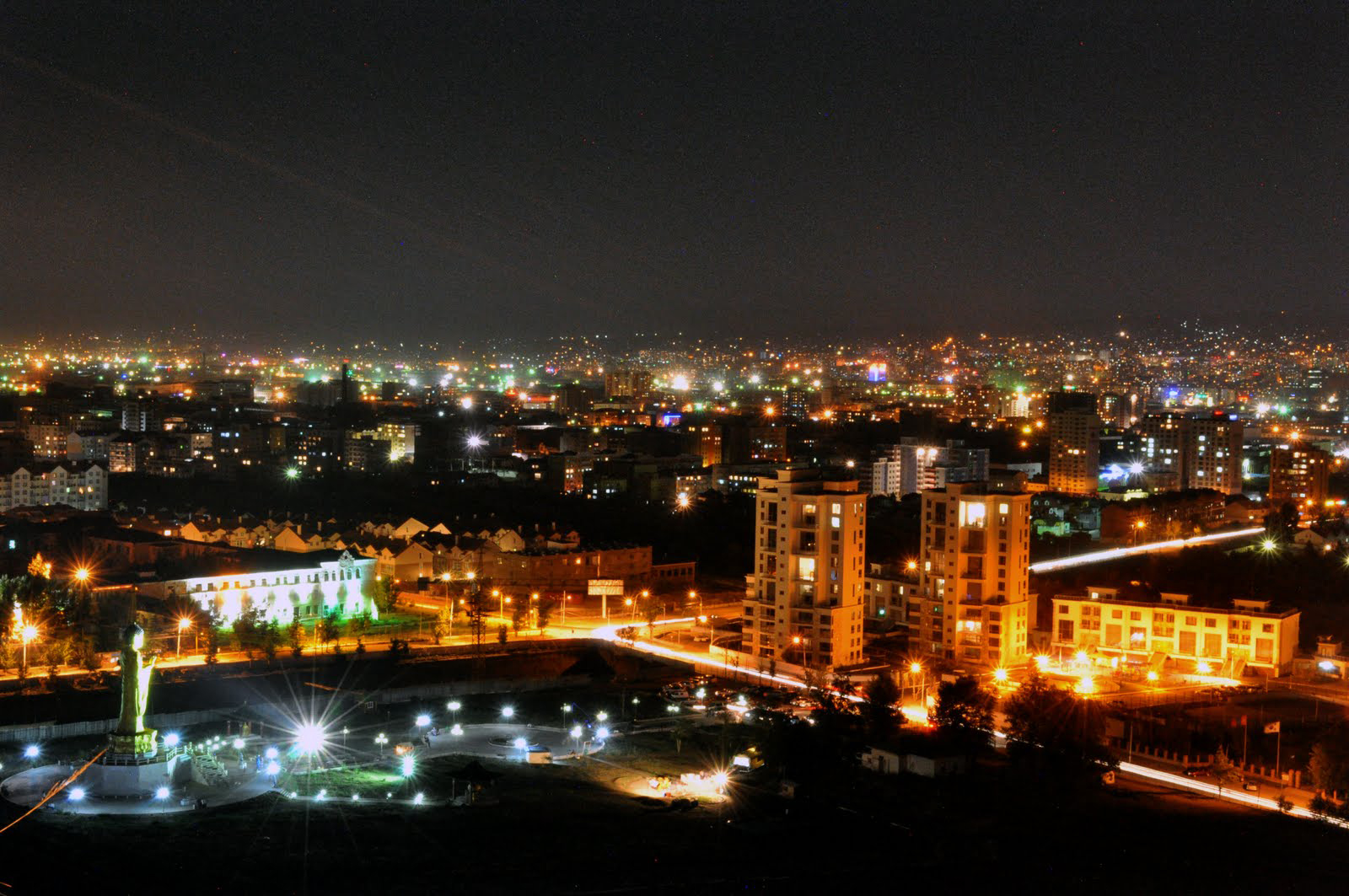 With over one-third of the country's population, Ulaanbaatar is by far Mongolia's largest city. It is also the transport and industrial center of the country. Often shortened to UB by foreigners, Mongolia's capital still has the look and feel of a neglected European city from the 1950s - but not for long. The old Soviet cars and buses are being replaced by newer Japanese models, apartments are being converted into flashy shops and it seems that every young Mongolian now has a mobile phone. Ulaanbaatar prides itself on being an increasingly modern (though still very laid-back) city. Despite all this, men and women still stroll along the main streets in traditional dress. Built along the river, the Tuul River, and surrounded by picturesque mountains, the center of Ulaanbaatar is dominated by Soviet-style high-rise apartment blocks. Yet about 250,000 locals live in sprawling suburbs on the outskirts of the city, opting to live in traditional Ger. It is a very pleasant place to visit and to base yourself for trips around the country. The city has interesting monasteries and museums and excellent cultural shows, so try to spend some time here before heading out to the glorious valleys, steppes or desert of Mongolia
With over one-third of the country's population, Ulaanbaatar is by far Mongolia's largest city. It is also the transport and industrial center of the country. Often shortened to UB by foreigners, Mongolia's capital still has the look and feel of a neglected European city from the 1950s - but not for long. The old Soviet cars and buses are being replaced by newer Japanese models, apartments are being converted into flashy shops and it seems that every young Mongolian now has a mobile phone. Ulaanbaatar prides itself on being an increasingly modern (though still very laid-back) city. Despite all this, men and women still stroll along the main streets in traditional dress. Built along the river, the Tuul River, and surrounded by picturesque mountains, the center of Ulaanbaatar is dominated by Soviet-style high-rise apartment blocks. Yet about 250,000 locals live in sprawling suburbs on the outskirts of the city, opting to live in traditional Ger. It is a very pleasant place to visit and to base yourself for trips around the country. The city has interesting monasteries and museums and excellent cultural shows, so try to spend some time here before heading out to the glorious valleys, steppes or desert of Mongolia
Places to visit: Chinggis Khaan Square, National History Museum, Gandan Monastery, Bogd Khaan Palace Museum, The Zanabazar Museum of Fine Art.
Activities: Monastery and museum visiting, sightseeing, dining, shopping, traditional folk concert
Chinggis Khaan Square
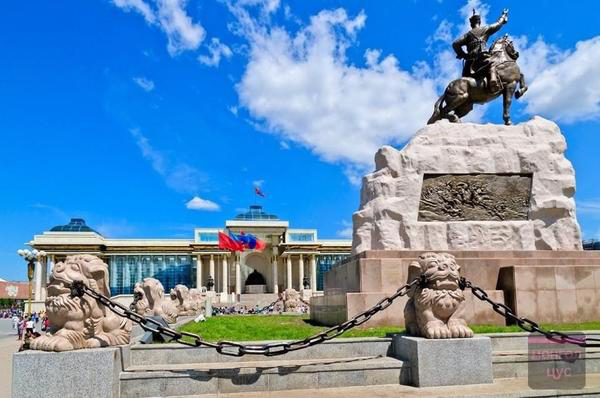 The square features a bronze statue of Sukhbaatar (1921-Revolutionary hero of Mongolia) astride his horse. In 2013 the city authorities changed the name from Sukhbaatar Square to Chinggis Khaan Square, although many citizens still refer to it by the old name. The enormous marble construction at the north end was completed in 2006 in time for the 800th anniversary of Chinggis Khaan’s coronation. At its centre is a seated bronze Chinggis Khaan Statue, lording it over his nation. He is flanked by Ogedei (on the west) and Khublai (east). Two famed Mongol soldiers (Boorchu and Mukhlai) guard the entrance to the monument. Behind the Chinggis monument stands Parliament House, which is commonly known as Government House. To the east of the square is the 1970s Soviet-style Cultural Palace, a useful landmark containing the Mongolian National Modern Art Gallery and several other cultural institutions. At the southeast corner of the square, the State Opera & Ballet Theatre. Just south of the Opera House is the symbol of the country's new wealth, Central Tower, which houses luxury shops including Louis Vuitton and Armani.
The square features a bronze statue of Sukhbaatar (1921-Revolutionary hero of Mongolia) astride his horse. In 2013 the city authorities changed the name from Sukhbaatar Square to Chinggis Khaan Square, although many citizens still refer to it by the old name. The enormous marble construction at the north end was completed in 2006 in time for the 800th anniversary of Chinggis Khaan’s coronation. At its centre is a seated bronze Chinggis Khaan Statue, lording it over his nation. He is flanked by Ogedei (on the west) and Khublai (east). Two famed Mongol soldiers (Boorchu and Mukhlai) guard the entrance to the monument. Behind the Chinggis monument stands Parliament House, which is commonly known as Government House. To the east of the square is the 1970s Soviet-style Cultural Palace, a useful landmark containing the Mongolian National Modern Art Gallery and several other cultural institutions. At the southeast corner of the square, the State Opera & Ballet Theatre. Just south of the Opera House is the symbol of the country's new wealth, Central Tower, which houses luxury shops including Louis Vuitton and Armani.
National History Museum
Exhibits of the museum show the history and culture of Mongols from ages as early as the Stone Age and up to the modern days. Among 15 thousand exhibits of the museum are carpet and silk items of the Xiongnu period and leather boots of a Mongolian soldier of that time. The 1st floor has some interesting exhibits on petroglyphs, deer stones (stone sculptures of reindeer and other animals) and burial sites from the Xiongnu and Uyghur eras. The 2nd floor houses an outstanding collection of costumes, hats and jewellery, representing most of Mongolia's ethnic groups.
The 3rd floor is a must-see for fans of the Mongol horde. The collection includes real examples of 12th century Mongol Armour, and correspondence between Pope Innocent IV and Guyuk Khaan. Written in Latin and Persian and dated November 13, 1246, it bears the khaan's seal. There is also a display of traditional Mongolian culture with, among other things, a furnished Ger, traditional farming and domestic implements, saddles and musical instruments.
Gandan Monastery
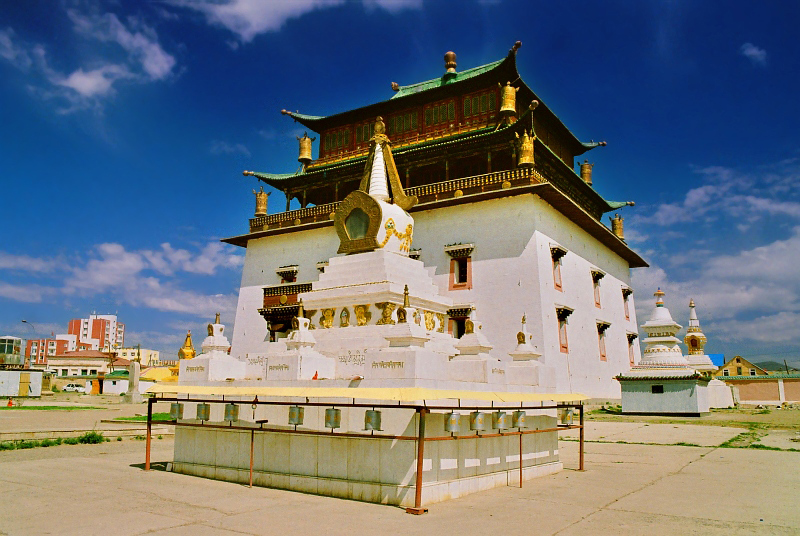 Originally situated in the center of Ulaanbaatar, Gandan Monastery was moved to its present location by the 5th Bogd Jebzundamba in 1838. Over the next century the Monastery grew to include nine datsans or institutes, a library and housed a community of around 5000 monks. Gandan became an important center for learning and practicing Buddha's teachings, not only in Mongolia but for the entire Mahayana Buddhist community. Small mobile monasteries functioned in Mongolia, and in 1838 the Gandantegchinlen monastery was founded as the religious center of Sutra-Tantra Buddhism at the site of Dalkha hill. It grew into a complex of colleges including a college of basic Buddhist teachings, departments of Astrology and Medicine, and as such was the largest center of the Mongolian Buddhism. The first temple of the Monastery was built at the initiative of the Mongolian living Buddha, the Fifth Incarnation Bogdo, Chultem-Jigmid-Dambijantsan. It was constructed by Mongolian masters and made mostly of wood and earth following Mongolian national architectural designs, with gold plated roofes and topmost Buddhist symbolic - decorations. Many of the Boddhisattvas statues and images established in Gandan temple are of significance. In the temple there are a bronze statue of the Lofty Noble Rimpoche Zanabazar - the Mongolian living Buddha of the First Incarnation sculpted by himself at the behest of his mother; the collection of the Buddha's fundamental teachings, the Tripitaka (Gangiur) in 108 volumes; the silver statue of the famous Tsong (Khapa) of Amdo made in XVI century in Western Oirat Mongolia.
Originally situated in the center of Ulaanbaatar, Gandan Monastery was moved to its present location by the 5th Bogd Jebzundamba in 1838. Over the next century the Monastery grew to include nine datsans or institutes, a library and housed a community of around 5000 monks. Gandan became an important center for learning and practicing Buddha's teachings, not only in Mongolia but for the entire Mahayana Buddhist community. Small mobile monasteries functioned in Mongolia, and in 1838 the Gandantegchinlen monastery was founded as the religious center of Sutra-Tantra Buddhism at the site of Dalkha hill. It grew into a complex of colleges including a college of basic Buddhist teachings, departments of Astrology and Medicine, and as such was the largest center of the Mongolian Buddhism. The first temple of the Monastery was built at the initiative of the Mongolian living Buddha, the Fifth Incarnation Bogdo, Chultem-Jigmid-Dambijantsan. It was constructed by Mongolian masters and made mostly of wood and earth following Mongolian national architectural designs, with gold plated roofes and topmost Buddhist symbolic - decorations. Many of the Boddhisattvas statues and images established in Gandan temple are of significance. In the temple there are a bronze statue of the Lofty Noble Rimpoche Zanabazar - the Mongolian living Buddha of the First Incarnation sculpted by himself at the behest of his mother; the collection of the Buddha's fundamental teachings, the Tripitaka (Gangiur) in 108 volumes; the silver statue of the famous Tsong (Khapa) of Amdo made in XVI century in Western Oirat Mongolia.
In 1938, the communists suppressed religious communities in Mongolia. They destroyed around 700 monasteries, though a handful were turned into museums. The monks were killed, jailed, or forced to join the army or laity. Five temples of Gandan Monastery were destroyed. The remaining temples were used to accommodate Russian officials or used as barns to keep their horses. In 1944 after a petition from several monks, Gandan Monastery was reopened but its functions were carried out under the strict supervision of the socialist government. In 1990, after the Democratic Revolution and with Buddhism flourishing once more, Gandan Monastery embarked on an ambitious restoration program around the country. There are currently 10 datsans and temples operating at Gandan Monastery, and approximately 900 monks.
The Migjid Janraisig Temple is an important part of Gandan Monastery. The temple houses the majestic new gilded statue of Migjid Janraisig, decorated with jewels. This 26 meter high 20 ton statue is a copy of another statue that was destroyed in the 1920's by communists. The statue was built with donations of Mongolian people as symbol of Buddhist revival in the mid 1990's.
Bogd khaan Palace Museum
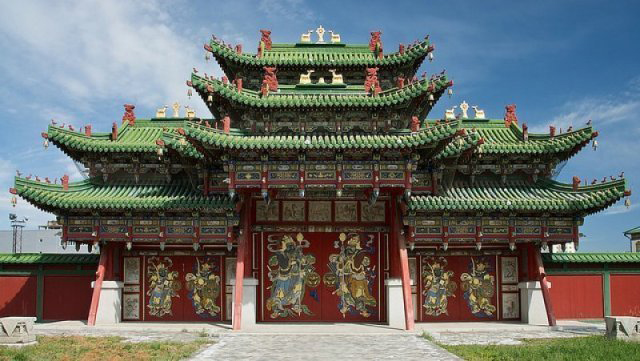 The Winter Palace of Bogd Khaan - one of the first museums in Mongolia - was built in 1924. It used to be a winter residence of the last Bogd Khaan of Mongolia, Javzandamba. The palace compound was built between 1893 and 1903, and is well known for its Gate of Peace, Temple and personal library of Bogd Khaan. Among the museum's exhibits are sculptures by Mongolia's first Bogdo Zanabazar, the famous Taras. The museum has 21 invaluable sculptures of Taras. The collections at the Palace Museum numbers over 8,000 exhibits, of these 72 are certified by the State as unique but others are priceless artifacts. This is the only remaining palace out of four residences where Bogd Khaan, the last Mongolian ruler, resided. This palace now displays the collection of personal belongings of the last Khaan and his wife. The museum offers a wide variety of Buddhist arts.
The Winter Palace of Bogd Khaan - one of the first museums in Mongolia - was built in 1924. It used to be a winter residence of the last Bogd Khaan of Mongolia, Javzandamba. The palace compound was built between 1893 and 1903, and is well known for its Gate of Peace, Temple and personal library of Bogd Khaan. Among the museum's exhibits are sculptures by Mongolia's first Bogdo Zanabazar, the famous Taras. The museum has 21 invaluable sculptures of Taras. The collections at the Palace Museum numbers over 8,000 exhibits, of these 72 are certified by the State as unique but others are priceless artifacts. This is the only remaining palace out of four residences where Bogd Khaan, the last Mongolian ruler, resided. This palace now displays the collection of personal belongings of the last Khaan and his wife. The museum offers a wide variety of Buddhist arts.
The Bogd Khaan Palace Museum comprises of two parts, which are the summer palace with seven temples and pagodas and the winter palace, a two story, white construction built in a European architectural style. There are mostly ancient statues of gods in the summer palace. Hence every year two great religious rituals are used here and staged to worship the sky and water spirits. There is also a tent decorated with sculptures of birds, animals and horseman. In the winter palace, built as a project by architects of Tsarist Russia (1893-1903), the Bogd Khaan along with his queen, Dondogdulam Khatan (1874-1923) spent the wintertime for 20 years. The Palace Museum preserves priceless historical and cultural monuments of the Mongolian State and religion from the 17th to 20th Centuries, together with artifacts created by the foremost masters of that time, Zanabazar in particular, ranging from statues of gods, thangkas, and papier-mache
The Zanabazar Museum of Fine Art
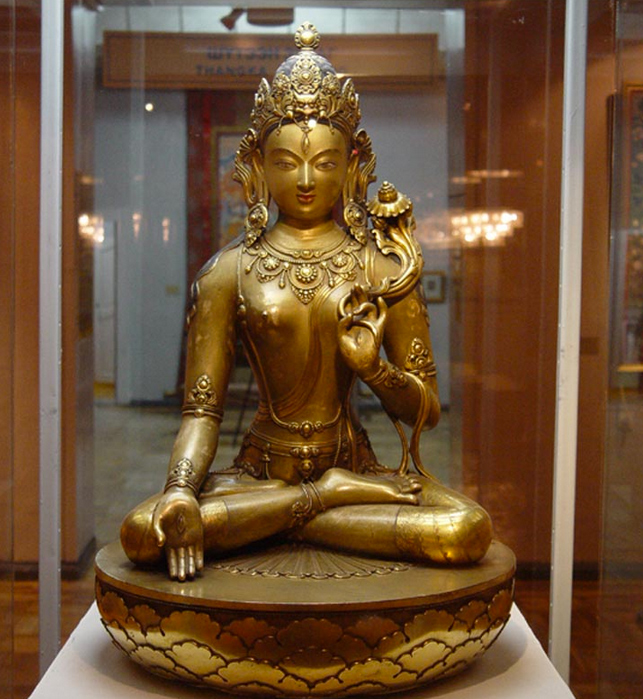 Zanabazar Museum of Fine Art in Ulaanbaatar was founded in 1966. Visitors can enjoy works of Mongolia's famous artists, and sculptors who lived before or in the early 20th century. Sculptures by Mongolia's first Bogdo and famous sculptor Zanabazar ("Five Gods" and "Taras"), as well as appliqués and sculptures in wood and stone by talented Mongolian craftsmen are among the 10 thousand exhibits of the museum. 25 of the 45 most precious works of art created by Mongolia's artists can be found in the museum. The Zanabazar Museum of Fine Arts has an excellent collection of paintings, carvings and sculptures, including many by the revered sculptor and artist Zanabazar. It also contains other rare and sometimes old - religious exhibits such as scroll paintings (thangka) and Buddhist statues, representing the best display of its kind in Mongolia. At the top of the stairs is a glass folder with a detailed explanation of Zanabazar and his work. There are some fine examples of the sculptor's work including five Dhyani, or Contemplation, Buddha’s (cast in 1683) and Tara in her 21 manifestations. Also worth checking out are the wonderful tsam masks (worn by monks during religious ceremonies) and the intricate paintings, One Day in Mongolia and The Airag Feast, by renowned artist В. Sharav. These depict almost every aspect of nomadic life. The ground floor has some copies of portraits of the great khaans (kings) and some 7th century Turkic carvings.
Zanabazar Museum of Fine Art in Ulaanbaatar was founded in 1966. Visitors can enjoy works of Mongolia's famous artists, and sculptors who lived before or in the early 20th century. Sculptures by Mongolia's first Bogdo and famous sculptor Zanabazar ("Five Gods" and "Taras"), as well as appliqués and sculptures in wood and stone by talented Mongolian craftsmen are among the 10 thousand exhibits of the museum. 25 of the 45 most precious works of art created by Mongolia's artists can be found in the museum. The Zanabazar Museum of Fine Arts has an excellent collection of paintings, carvings and sculptures, including many by the revered sculptor and artist Zanabazar. It also contains other rare and sometimes old - religious exhibits such as scroll paintings (thangka) and Buddhist statues, representing the best display of its kind in Mongolia. At the top of the stairs is a glass folder with a detailed explanation of Zanabazar and his work. There are some fine examples of the sculptor's work including five Dhyani, or Contemplation, Buddha’s (cast in 1683) and Tara in her 21 manifestations. Also worth checking out are the wonderful tsam masks (worn by monks during religious ceremonies) and the intricate paintings, One Day in Mongolia and The Airag Feast, by renowned artist В. Sharav. These depict almost every aspect of nomadic life. The ground floor has some copies of portraits of the great khaans (kings) and some 7th century Turkic carvings.
AROUND ULAANBAATAR
Places to visit: Terelj National Park, Chinggis Khaan Statue, 13 th Century Complex Park, Bogd Khaan National Park, Hustai National Park, Gun Galuut Nature Reserve
Activities: Monastery visiting, hiking, rafting, horse riding, camel riding, bird watching, wildlife viewing, fishing, nomadic culture experiencing, camping in the wild.
Terelj National Park
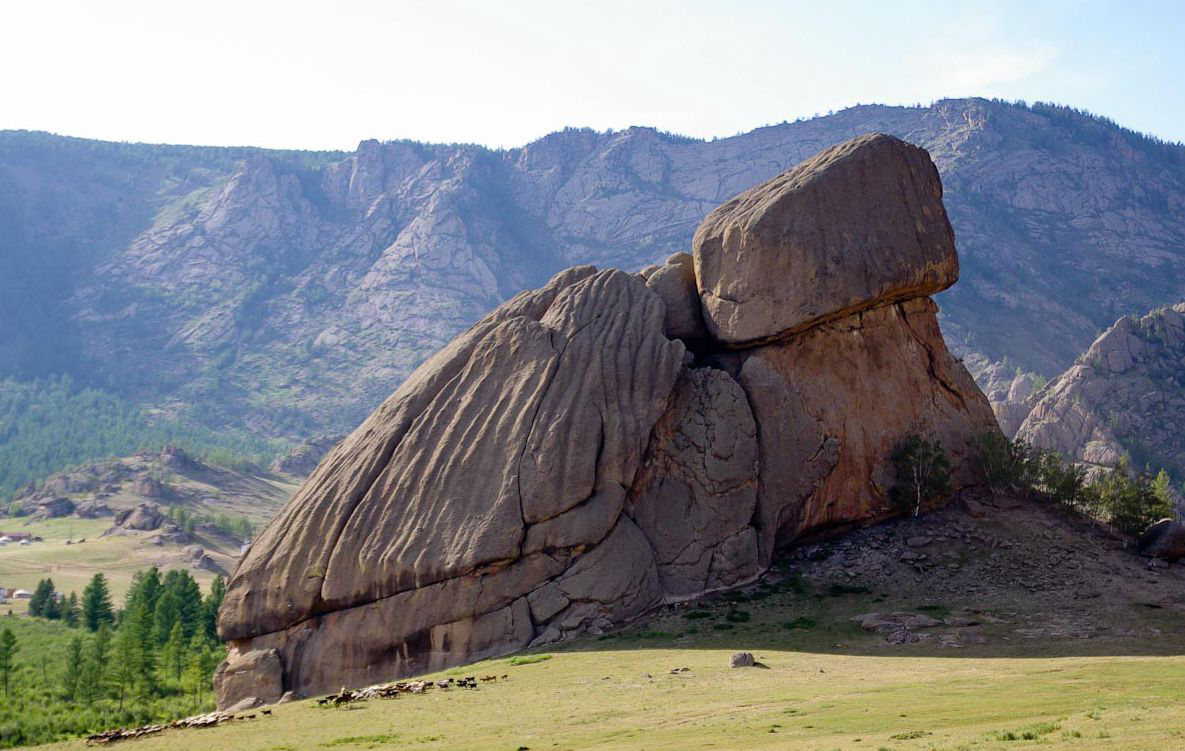 Terelj, about 80km north-east of Ulaanbaatar, is a deservedly popular destination. At 1600m, the area is cool and the alpine scenery is magnificent, and there are great opportunities for hiking, rock climbing, swimming, rafting, horse riding, visiting nomad family and so on. Most visited are the turtle rock and the dinosaur’s park. Terelj was first developed for tourism in 1964 and 30 years later it became part of the Gorkhi-Terelj National Park. To the north-east, the park joins into the Khan Khentii Strictly Protected Area, comprising over 1.2 million hectares of the Tov, Selenge and Khentii aimags. The Khan Khentii park is almost completely uninhabited by humans, but it is home to endangered species of moose, brown bear and weasel, to name but a few, and to over 250 species of birds. Also there is a small Buddhist meditation temple Ariyabal nestled in the park’s rocky mountainside. The entrance of the gate is accessible by car, hiking or on horseback. The distance between the gate and the actual temple is about 1 km and it is only accessible by walking. To get to the top, you would cross the suspension bridge and climb up on 108 stairs, according to Buddhist prayer beads. This small hike is seen as a ritual to cleanse one’s sins. The temple, when observed from distance, can be seen as a beautiful white elephant and the staircase looks as if the dangling elephant’s trunk. From the top, you can enjoy the breathtaking view overlooking the Terelj National Park.
Terelj, about 80km north-east of Ulaanbaatar, is a deservedly popular destination. At 1600m, the area is cool and the alpine scenery is magnificent, and there are great opportunities for hiking, rock climbing, swimming, rafting, horse riding, visiting nomad family and so on. Most visited are the turtle rock and the dinosaur’s park. Terelj was first developed for tourism in 1964 and 30 years later it became part of the Gorkhi-Terelj National Park. To the north-east, the park joins into the Khan Khentii Strictly Protected Area, comprising over 1.2 million hectares of the Tov, Selenge and Khentii aimags. The Khan Khentii park is almost completely uninhabited by humans, but it is home to endangered species of moose, brown bear and weasel, to name but a few, and to over 250 species of birds. Also there is a small Buddhist meditation temple Ariyabal nestled in the park’s rocky mountainside. The entrance of the gate is accessible by car, hiking or on horseback. The distance between the gate and the actual temple is about 1 km and it is only accessible by walking. To get to the top, you would cross the suspension bridge and climb up on 108 stairs, according to Buddhist prayer beads. This small hike is seen as a ritual to cleanse one’s sins. The temple, when observed from distance, can be seen as a beautiful white elephant and the staircase looks as if the dangling elephant’s trunk. From the top, you can enjoy the breathtaking view overlooking the Terelj National Park.
Chinggis Khaan Statue
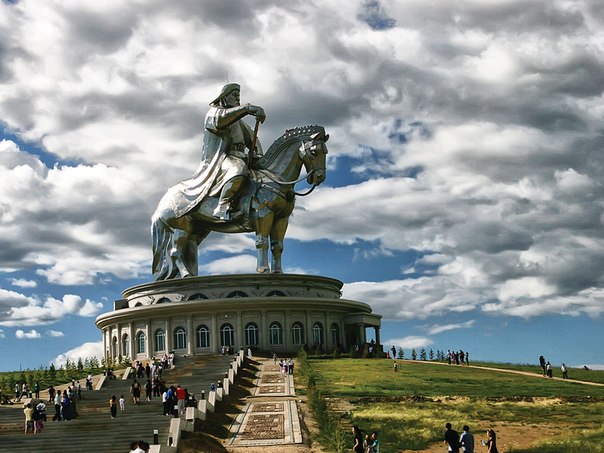 A gigantic statue of Chinggis Khaan riding on horseback was erected in 2008 on the bank of the Tuul River at Tsonjin Boldog, 54 km east of the Mongolian capital Ulaanbaatar, where according to legend, he found a golden whip. Here, Temujin (Chinggis Khaan's childhood name) becoming the great Khaan who conquered half the world after overcoming difficulties in his childhood when he lost his father, found a whip on the way back from Khereid's Toiril Khan, where he had gone to ask for help when Mergid had captured his wife in 1117. Finding a whip is perceived by Mongolians as a good omen. Therefore, finding the whip, Chinggis Khaan became greedy seeing it as a path being opened to the great cause. The haughty and yet honorable statue is surrounded by 36 columns representing 36 Mongolian Khaans. The entire edifice is covered in 250 tonne of steel. Visitors will ascend to the exhibition hall using an elevator at the back of the horse and will walk to the horse's head passing through its chest and the back of its neck from where they will have an excellent panoramic view over the complex area and the scenery beyond. The statue is currently largest equastrian statue in the world.
A gigantic statue of Chinggis Khaan riding on horseback was erected in 2008 on the bank of the Tuul River at Tsonjin Boldog, 54 km east of the Mongolian capital Ulaanbaatar, where according to legend, he found a golden whip. Here, Temujin (Chinggis Khaan's childhood name) becoming the great Khaan who conquered half the world after overcoming difficulties in his childhood when he lost his father, found a whip on the way back from Khereid's Toiril Khan, where he had gone to ask for help when Mergid had captured his wife in 1117. Finding a whip is perceived by Mongolians as a good omen. Therefore, finding the whip, Chinggis Khaan became greedy seeing it as a path being opened to the great cause. The haughty and yet honorable statue is surrounded by 36 columns representing 36 Mongolian Khaans. The entire edifice is covered in 250 tonne of steel. Visitors will ascend to the exhibition hall using an elevator at the back of the horse and will walk to the horse's head passing through its chest and the back of its neck from where they will have an excellent panoramic view over the complex area and the scenery beyond. The statue is currently largest equastrian statue in the world.
13 th Century Complex Park
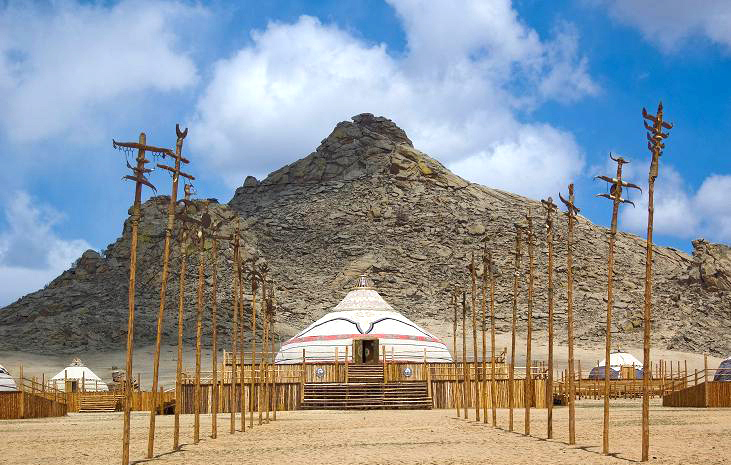 “13th Century National Park” is located in Erdene country,Yol Mountain 96 km from Ulaanbaatar. The goal of “13th century” national park is build and establish real-time micro kingdom to make the lively feeling for its guests during their stay by genuinely providing true environment of the way of living and working of the 13th century. Visitors can enjoy annual celebrations, customs such as making felt cover for Gers, sling wool, sacred ceremony to praise flag, heaven by sacrificing, wedding, weeping camel, mare milking, sealing folks and organizing three games of men. Here the guests can dine with Khaans and Queens visit the residents of lords and learn to write in Mongolian scripts and play in horse-headed fiddle /Morin khuur/. “13th Century National Park” consisted with six camps and tribes provide the service to the tourists
“13th Century National Park” is located in Erdene country,Yol Mountain 96 km from Ulaanbaatar. The goal of “13th century” national park is build and establish real-time micro kingdom to make the lively feeling for its guests during their stay by genuinely providing true environment of the way of living and working of the 13th century. Visitors can enjoy annual celebrations, customs such as making felt cover for Gers, sling wool, sacred ceremony to praise flag, heaven by sacrificing, wedding, weeping camel, mare milking, sealing folks and organizing three games of men. Here the guests can dine with Khaans and Queens visit the residents of lords and learn to write in Mongolian scripts and play in horse-headed fiddle /Morin khuur/. “13th Century National Park” consisted with six camps and tribes provide the service to the tourists
Bogd Khaan Mountain National Park
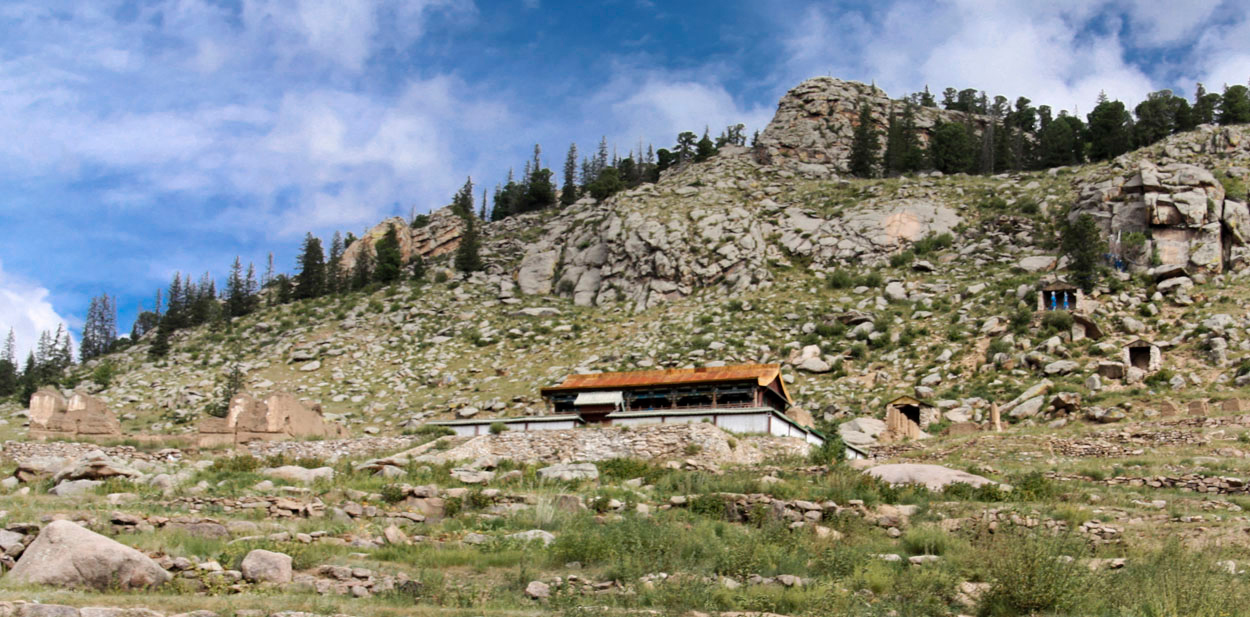 One of the two most popular destinations outside of Ulaanbaatar is Mt.Bogd khaan National Park. Lying to the south of Ulaanbaatar, Bogd Khaan Mountain has been a national park of the country since 300 years ago. The main entrance to the National Park is 46 kilometers to the south west of the city. With its nature and wildlife intact, Bogd Khaan Mountain boasts its beautiful scenery with green forests of pine, cedar, larch and birch covering the mountain. Place is ideal for hiking, horse riding and climbing as well as exploring the nomads daily lifestyle. Also you can visit the Manzushir monastery, 18-th century monastery in Southern reserve. Established in 1733, it had over 20 temples and was once home to at least 300 monks.
One of the two most popular destinations outside of Ulaanbaatar is Mt.Bogd khaan National Park. Lying to the south of Ulaanbaatar, Bogd Khaan Mountain has been a national park of the country since 300 years ago. The main entrance to the National Park is 46 kilometers to the south west of the city. With its nature and wildlife intact, Bogd Khaan Mountain boasts its beautiful scenery with green forests of pine, cedar, larch and birch covering the mountain. Place is ideal for hiking, horse riding and climbing as well as exploring the nomads daily lifestyle. Also you can visit the Manzushir monastery, 18-th century monastery in Southern reserve. Established in 1733, it had over 20 temples and was once home to at least 300 monks.
Hustai National Park
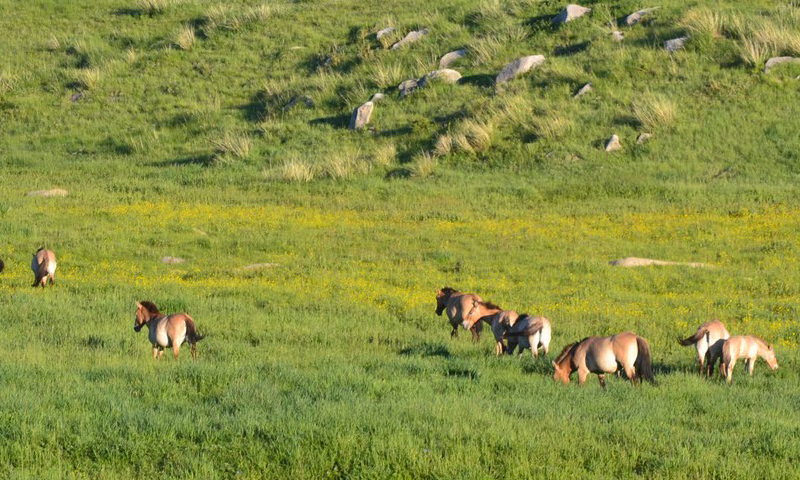 The Hustai National Park protected area lies 100km southwest of Ulaanbaatar and was established in 1993 to preserve Mongolia’s wild takhi (przewalski’s) horses and the environment in which they live. The takhi horse is unique to Mongolia where it existed until the 1960s. It is believed these horses have direct genetic links to prehistoric horses. After the sad extinction of the takhi horses in the wild, these beautiful animals have been reintroduced from captivity and they have taken well to their new freedom. They are not particularly afraid of humans and the harems (one stallion and several mares) are known to come quite close if visitors are quiet and calm. On the territory of Hustai National Park and its buffer zone there are many historical monuments exist like: monument ensemble of Ungut-famous with it is large number of man like figures, which belongs to 6-8 th century and. many other sepultures, rectangular tombs and ruin of old monastery.
The Hustai National Park protected area lies 100km southwest of Ulaanbaatar and was established in 1993 to preserve Mongolia’s wild takhi (przewalski’s) horses and the environment in which they live. The takhi horse is unique to Mongolia where it existed until the 1960s. It is believed these horses have direct genetic links to prehistoric horses. After the sad extinction of the takhi horses in the wild, these beautiful animals have been reintroduced from captivity and they have taken well to their new freedom. They are not particularly afraid of humans and the harems (one stallion and several mares) are known to come quite close if visitors are quiet and calm. On the territory of Hustai National Park and its buffer zone there are many historical monuments exist like: monument ensemble of Ungut-famous with it is large number of man like figures, which belongs to 6-8 th century and. many other sepultures, rectangular tombs and ruin of old monastery.
Gun Galuut Nature Reserve
 It is one of the most popular eco destinations of Mongolia and covers about 20000 hectare. Amazingly, Gun-Galuut is the state combined from diversity of ecosystem although it owns comparatively small area. The harmonized complex of high mountains, steppes, rivers, lakes and wetlands as well are kept enough as its original condition. It is a home to endangered wild Mountain sheep-Argali, White napped crane, Siberian white crane, Hooded crane and the rare black stork, Azian heron, Whooper swan, Swan goose and so on. Over 200 Argali sheep inhabit peacefully in Gun Galuut now. Whoever visiting enjoys to see Gun-Galuut vast steppe seems to meet the sky, the imposing mountains Baits and Berkh, a home land of rare creatures, Ikh-Gun and Ayaga lakes, a paradise of birds, Kherlen, the longest river of Mongolia and Tsengiin Burd wetland, in where water and wetland birds lay their eggs. Place is ideal for hiking, horse and camel riding, bird watching and experiencing lifestyle of local nomad people, rafting and fishing, camping in the wild or just watching wild animals and enjoying photo opportunities.
It is one of the most popular eco destinations of Mongolia and covers about 20000 hectare. Amazingly, Gun-Galuut is the state combined from diversity of ecosystem although it owns comparatively small area. The harmonized complex of high mountains, steppes, rivers, lakes and wetlands as well are kept enough as its original condition. It is a home to endangered wild Mountain sheep-Argali, White napped crane, Siberian white crane, Hooded crane and the rare black stork, Azian heron, Whooper swan, Swan goose and so on. Over 200 Argali sheep inhabit peacefully in Gun Galuut now. Whoever visiting enjoys to see Gun-Galuut vast steppe seems to meet the sky, the imposing mountains Baits and Berkh, a home land of rare creatures, Ikh-Gun and Ayaga lakes, a paradise of birds, Kherlen, the longest river of Mongolia and Tsengiin Burd wetland, in where water and wetland birds lay their eggs. Place is ideal for hiking, horse and camel riding, bird watching and experiencing lifestyle of local nomad people, rafting and fishing, camping in the wild or just watching wild animals and enjoying photo opportunities.
CENTRAL MONGOLIA
Central Mongolia is beautiful, pristine and rich in wild species and has been keeping many important historical and cultural remains of different historical periods. In central Mongolia, you can discover distinctive natural zones of forested steppes, mountain steppes and Gobi desert and their breathtaking natural beauties and interesting cultural and historical items.
Places to visit: Khangai mountains, Khogno Khan Natural Reserve, Elsen Tasarkhai sand dunes, Ancient capital of Mongol empire Karakorum, Buddhist monastery Erdene Zuu, Tuvkhun monastery, Tsenkher hot spa, Khushuu Tsaidam Monument, Orkhon waterfall, Naiman Nuur National Monument, Ogii lake, Khorgo -Terkh National Park.
Activities: Hiking, horse riding, camel riding, experiencing nomadic culture, monastery visiting, sightseeing, fishing, bird watching, camping in the wild.
Khogno Khan Natural Reserve & Elsen Tasarkhai sand dunes
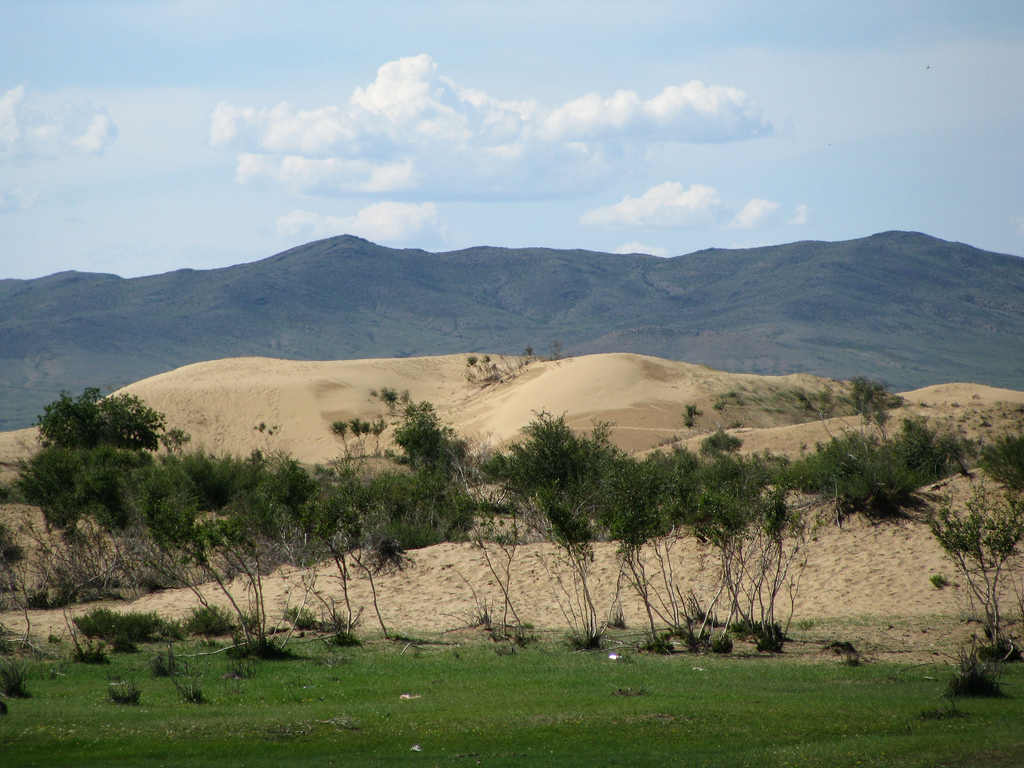 Khogno Khan Natural Reserve covers 46,990 hectares of land and is located in Rashaant county of Bulgan province. The taiga and steppe plants grow in this area and represent two or three different natural zones. This area was taken under state protection in 1997. Khogno Khan, a splendid mountain is situated in the border area of Uvurkhangai, Tuv and Bulgan province. This is a magnificent place with mountains, forests, steppes, Gobi-type desert and mineral water sources all in one location. There are many wild animals such as wolves, deers, foxes and snow leopards inhabited here. In Khogno Khan Natural Reserve, there is an extraordinary sand dunes called Elsen Tasarkhai. "Elsen tasarkhai" is a part of the Great Mongolian Sand dunes and extends about 80 km. The scenery is a perfect combination of desert, picturesque mountains, river and green grassland. One of the main attractions of this area is Uvgun monastery which was built in 17th century by Saint Zanabazar who was a great sculptor and the biggest representative of Buddhism in Mongolia. During Middle Age feuds between Western and Eastern Mongolians (Dzungaria and Khalkh Mongolia) after the collapse of the Mongol Empire, the armies of Dzungarian leader Galdan Boshigt noticed the golden roofs of the temples in Khogno Khan Mountain and massacred the partisan-monks of the rival Zanabazar in 1640, killing them by tying their necks with a rope (the Mongolian verb for the action is khognokh) as if they were goats and sheep. This is the meaning of name of the mountain. After democratic revolution in 1990 the monastery was restored by the granddaughter of the monks who was living at the monastery. This area is pleasant for many activities such as hiking, mountain climbing and horse riding.
Khogno Khan Natural Reserve covers 46,990 hectares of land and is located in Rashaant county of Bulgan province. The taiga and steppe plants grow in this area and represent two or three different natural zones. This area was taken under state protection in 1997. Khogno Khan, a splendid mountain is situated in the border area of Uvurkhangai, Tuv and Bulgan province. This is a magnificent place with mountains, forests, steppes, Gobi-type desert and mineral water sources all in one location. There are many wild animals such as wolves, deers, foxes and snow leopards inhabited here. In Khogno Khan Natural Reserve, there is an extraordinary sand dunes called Elsen Tasarkhai. "Elsen tasarkhai" is a part of the Great Mongolian Sand dunes and extends about 80 km. The scenery is a perfect combination of desert, picturesque mountains, river and green grassland. One of the main attractions of this area is Uvgun monastery which was built in 17th century by Saint Zanabazar who was a great sculptor and the biggest representative of Buddhism in Mongolia. During Middle Age feuds between Western and Eastern Mongolians (Dzungaria and Khalkh Mongolia) after the collapse of the Mongol Empire, the armies of Dzungarian leader Galdan Boshigt noticed the golden roofs of the temples in Khogno Khan Mountain and massacred the partisan-monks of the rival Zanabazar in 1640, killing them by tying their necks with a rope (the Mongolian verb for the action is khognokh) as if they were goats and sheep. This is the meaning of name of the mountain. After democratic revolution in 1990 the monastery was restored by the granddaughter of the monks who was living at the monastery. This area is pleasant for many activities such as hiking, mountain climbing and horse riding.
Karakorum
 Karakorum, ancient capital of Mongol empire, was established by Chinggis Khan in 1220 in the Orkhon valley at the crossroads of the Silk Road. Karakorum was a busy spindled city with high civilization built by the best artists and masters of antiquity.The ancient capital served as the political, cultural and economic capital of the Mongols for 40 years until Khublai Khan moved it to Khanbalik, in what is now Beijing. Following the move to Beijing, Karakorum was abandoned and then destroyed by the soldiers from Ming Dynasty in 1388.The remains of the capital that stood at the crossroads of the Silk Road are extensive underground archaeological assets and two granite turtles that once stood at the main gate to the city. Four of these turtle sculptures used to mark the boundaries of ancient Karakorum, acting as protectors of the city (turtles are considered as symbols of eternity). Later in 1586, Erdene Zuu, the first Buddhist monastery in Mongolia, was built on the ruins of the 13th century capital city. Nowadays there is small town called Kharkhorin, which is 360 km from Ulaanbaatar city. Kharkhorin is located at the lower end of the upper valley of the Orkhon River, which is part if the World Heritage Site Orkhon Valley Cultural Landscape.
Karakorum, ancient capital of Mongol empire, was established by Chinggis Khan in 1220 in the Orkhon valley at the crossroads of the Silk Road. Karakorum was a busy spindled city with high civilization built by the best artists and masters of antiquity.The ancient capital served as the political, cultural and economic capital of the Mongols for 40 years until Khublai Khan moved it to Khanbalik, in what is now Beijing. Following the move to Beijing, Karakorum was abandoned and then destroyed by the soldiers from Ming Dynasty in 1388.The remains of the capital that stood at the crossroads of the Silk Road are extensive underground archaeological assets and two granite turtles that once stood at the main gate to the city. Four of these turtle sculptures used to mark the boundaries of ancient Karakorum, acting as protectors of the city (turtles are considered as symbols of eternity). Later in 1586, Erdene Zuu, the first Buddhist monastery in Mongolia, was built on the ruins of the 13th century capital city. Nowadays there is small town called Kharkhorin, which is 360 km from Ulaanbaatar city. Kharkhorin is located at the lower end of the upper valley of the Orkhon River, which is part if the World Heritage Site Orkhon Valley Cultural Landscape.
Erdene Zuu monastery
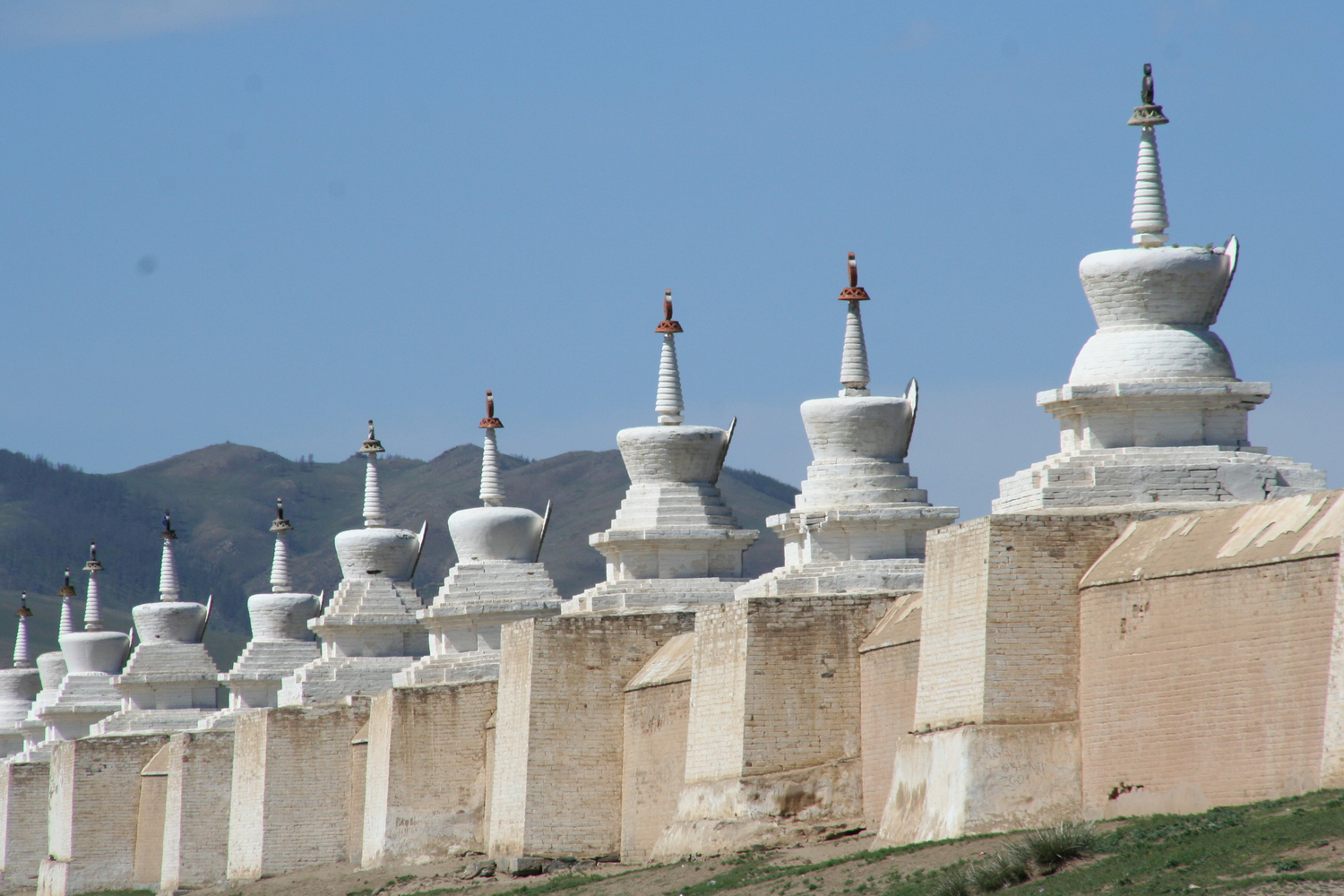 Erdene Zuu Khiid - The first Buddhist monastery called Erdene-Zuu was built on ruins of Karakorum. It was built in 1586 at the initiative of Abtai Khan, most influential Prince of that time in Mongolia.The monastery occupies an area surrounded by a stone wall with 108 stupas lining on it. The Erdene-Zuu monastery preserves marvelous works of Mongolian artists, painters, cutters, sculptors, embroiders and craftsman of the XVII-XIX centuries. It had between 60 and 100 temples, about 300 gers inside the walls and, at its peak, up to 1000 monks in residence. Erdene zuu Monastery was destroyed by communists in 1930s during the political purge. Suprisingly, many Buddha images and statues, tsam masks and thangkas were saved by locals. The monastery was closed until 1965 and reintroduced as a museum to public. After democratic revolution in 1990, religious freedom was restored and monastery became active again. The monastery is enclosed in an immense walled compound surrounded by 108 stupas. The three temples in the compound, which were not destroyed in the 1930s, are dedicated to the three stages of Buddha's life: childhood, adolescence and adulthood. Dalai Lama Temple was built in 1675 to commemorate the visit by Abtai Khan's son, Altan, to the Dalai Lama in Tibet. The temple accommodates statue of Zanabazar and some fine 17th-century thangkas depicting the Dalai Lamas and various protector deities.
Erdene Zuu Khiid - The first Buddhist monastery called Erdene-Zuu was built on ruins of Karakorum. It was built in 1586 at the initiative of Abtai Khan, most influential Prince of that time in Mongolia.The monastery occupies an area surrounded by a stone wall with 108 stupas lining on it. The Erdene-Zuu monastery preserves marvelous works of Mongolian artists, painters, cutters, sculptors, embroiders and craftsman of the XVII-XIX centuries. It had between 60 and 100 temples, about 300 gers inside the walls and, at its peak, up to 1000 monks in residence. Erdene zuu Monastery was destroyed by communists in 1930s during the political purge. Suprisingly, many Buddha images and statues, tsam masks and thangkas were saved by locals. The monastery was closed until 1965 and reintroduced as a museum to public. After democratic revolution in 1990, religious freedom was restored and monastery became active again. The monastery is enclosed in an immense walled compound surrounded by 108 stupas. The three temples in the compound, which were not destroyed in the 1930s, are dedicated to the three stages of Buddha's life: childhood, adolescence and adulthood. Dalai Lama Temple was built in 1675 to commemorate the visit by Abtai Khan's son, Altan, to the Dalai Lama in Tibet. The temple accommodates statue of Zanabazar and some fine 17th-century thangkas depicting the Dalai Lamas and various protector deities.
Khushuu Tsaidam Monument
Khushuu Tsaidam Memoral Complex is a Turkic inscribed monument of Turkic Empire. The inscription was written by the grandson of Kultegin and devoted to the Bilge khan of Turkic Empire and his brother Kultegin in 732. Bilge Khan's stele, well khown Orkhon Inscription is 3,3 m high, 1,3 m wide and has 68 rows of inscription. Bilge Khan, who was the latest King of Turkic Empire, ruled its country for 19 years. During the excavation of the memorial in 31th of July 2001, over 2000 finds were revealed and the most important one among them was a gemstone inlaid golden crown of Bilge Khan. There are over 40 runic stele in Mongolia and about 10 of them are located only in Orkhon Valley, that is why it was named Orkhon inscription. These 2 stele of Bilge Khan and Kultegin are 1 km apart from each other. These memorials were recognized as a "Cultural landscape" of the UNESCO World Heritage in 1996, although they had been destroyed much throughout its history of over thousand years.
Ogii Lake
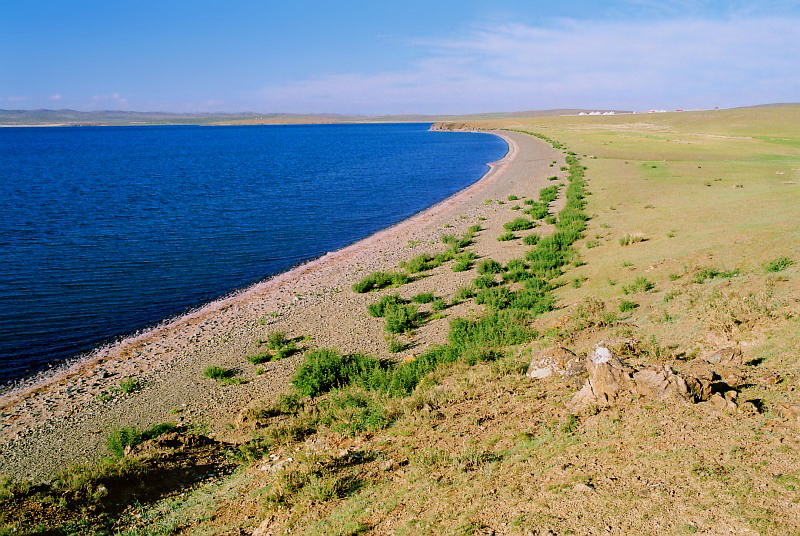 Ogii lake, locates on the centre of Mongolia, in the territory of the Arkhangai province, is one of the biggest lakes of Mongolia and has 27 km squire area. Average depth is 6.64m, in some sections 15.3m, coastal length is 23.5m. The lake abounds in various types of fish and birds, which create an incredible natural beauty. There are 150 sorts of extremely rare and rare species birds of passage come to settle down on the Ogii lake. It is home for cranes and ducks, also Swan Goose, White Spoonbill and Dalmatian Pelican have been recorded. Ogii lake has 14 sorts of fish belonged to the North Atlantic ocean area such as Esoc lucius, Rutilus lacustrisi, Perca fluviatilis, Leucisous idus, Cyprinus carpio haematopterus and so on. Delicate sand and whetstone coast, the soft wave makes an area is very convenient to have boat adventure. Also it is enthusiastic place for swimming, having sunbath, bird watching, fishing, horse and camel ridding and hiking.
Ogii lake, locates on the centre of Mongolia, in the territory of the Arkhangai province, is one of the biggest lakes of Mongolia and has 27 km squire area. Average depth is 6.64m, in some sections 15.3m, coastal length is 23.5m. The lake abounds in various types of fish and birds, which create an incredible natural beauty. There are 150 sorts of extremely rare and rare species birds of passage come to settle down on the Ogii lake. It is home for cranes and ducks, also Swan Goose, White Spoonbill and Dalmatian Pelican have been recorded. Ogii lake has 14 sorts of fish belonged to the North Atlantic ocean area such as Esoc lucius, Rutilus lacustrisi, Perca fluviatilis, Leucisous idus, Cyprinus carpio haematopterus and so on. Delicate sand and whetstone coast, the soft wave makes an area is very convenient to have boat adventure. Also it is enthusiastic place for swimming, having sunbath, bird watching, fishing, horse and camel ridding and hiking.
Naiman Nuur National Monument - 8 Lakes Region 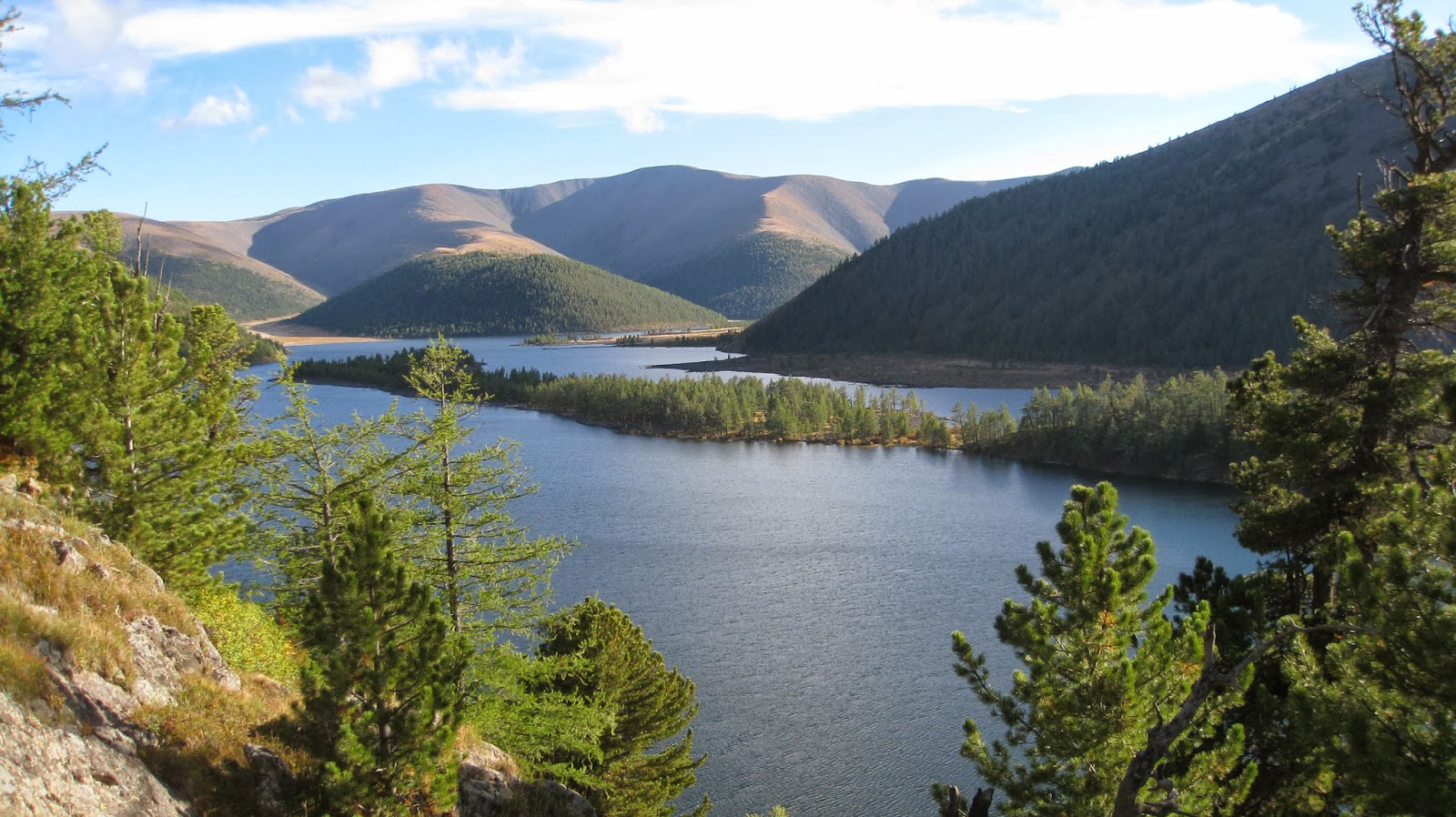 The Khuisiin Naiman Nuur National Monument is located in the Central Mongolian Khangai Mountain range and represents a typical high mountain area of Mongolia with max. The area of Naiman Nuur (Eight Lakes), which was created by volcanic eruptions centuries ago, is located on over 2,400 meters above sea level. The area of 11,500 hectare size was declared a National Monument in 1992. From the lakes, about 35 km southwest of Orkhon Waterfall, but the roads are often virtually impassible. The lakes are named Shireet, Khaliut, Bugat, Khaya, Khuis, Onon, Doroo and Bayan- Uul. The lakes located in a high mountain area with sub alpine mountain meadows and coniferous forests of Siberian Pine and Siberian Larch, flat valley areas with lava stone fields in the north of the protected area and barren mountain tops, and the lakes. In this area, there are 50 species of birds from 22 families have been recorded such as Black-throated Diver, Great Cormoran, Bar-headed Goose and Whooper Swan. Khuisyn Naiman Nuur National Monument with its exceptional configuration is surrounded by the beautiful nature of the middle part of the Khangai mountain range. Area is paradise for adventurous travelers, who likes trekking and horse back riding trips.
The Khuisiin Naiman Nuur National Monument is located in the Central Mongolian Khangai Mountain range and represents a typical high mountain area of Mongolia with max. The area of Naiman Nuur (Eight Lakes), which was created by volcanic eruptions centuries ago, is located on over 2,400 meters above sea level. The area of 11,500 hectare size was declared a National Monument in 1992. From the lakes, about 35 km southwest of Orkhon Waterfall, but the roads are often virtually impassible. The lakes are named Shireet, Khaliut, Bugat, Khaya, Khuis, Onon, Doroo and Bayan- Uul. The lakes located in a high mountain area with sub alpine mountain meadows and coniferous forests of Siberian Pine and Siberian Larch, flat valley areas with lava stone fields in the north of the protected area and barren mountain tops, and the lakes. In this area, there are 50 species of birds from 22 families have been recorded such as Black-throated Diver, Great Cormoran, Bar-headed Goose and Whooper Swan. Khuisyn Naiman Nuur National Monument with its exceptional configuration is surrounded by the beautiful nature of the middle part of the Khangai mountain range. Area is paradise for adventurous travelers, who likes trekking and horse back riding trips.
Orkhon waterfall
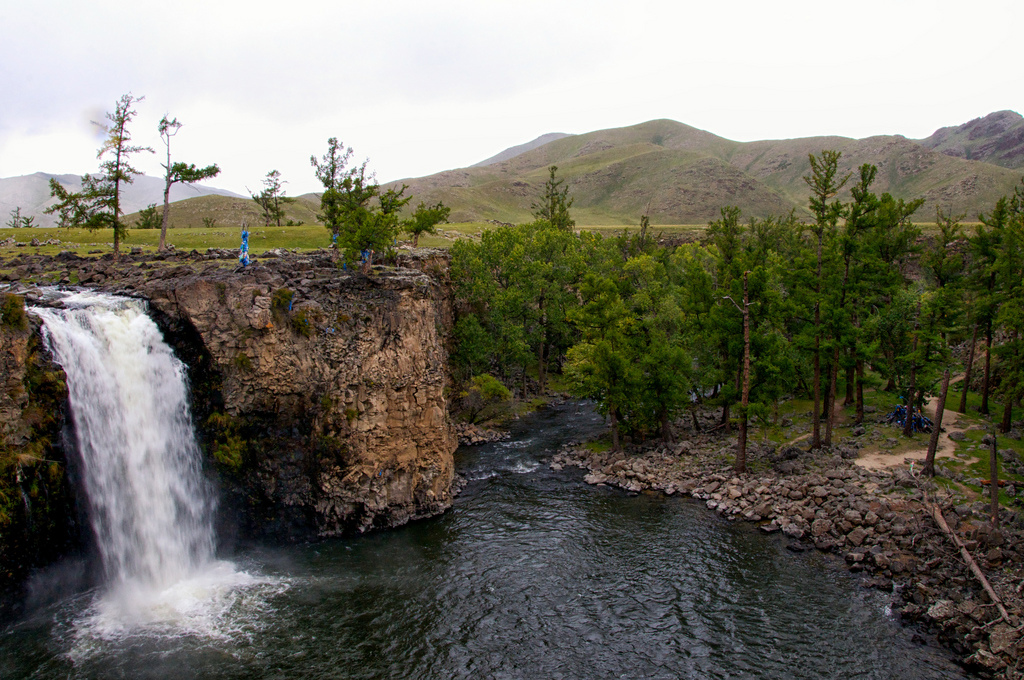
Over 25 m high Orkhon Waterfall is the biggest waterfall in Mongolia and one of the most attractive destination in Orkhon river valley, UNISCO World heritage site. It is located 90 km from Karakorum.
The surrounding areas of the waterfall was formed by volcanic activities dated back approximately 20,000 years (possibly Quaternary period). Orkhon is longest river in Mongolia with length of 1124 kilometers (709 miles) and formulates by springs at the numerous mouths of Suvraga Khairkhan a peak of Khangai mountain range. Flows of Orkhon River created a 130 km long canyon through the lava plateau.
The area is ideal for fishing, horse riding, cycling and photography. The rivers have handful species of river fish such as pike, sturgeon, hucho taimen, common asp, Siberian grayling, roach etc. Scenic and untouched natural distinct spot allow good opportunities for hiking and horseback riding. This valley is known as the home of Mongolian nomadic culture as many of Mongolia’s ancient monuments lie within its borders. Yak herder nomads are common. Because cars cannot drive to in, Trekking tours to Naiman nuur region (Eight Lakes) are always organized from here by the support of locals who hire their trained horses for transportation for luggage.
Tuvkhun monastery
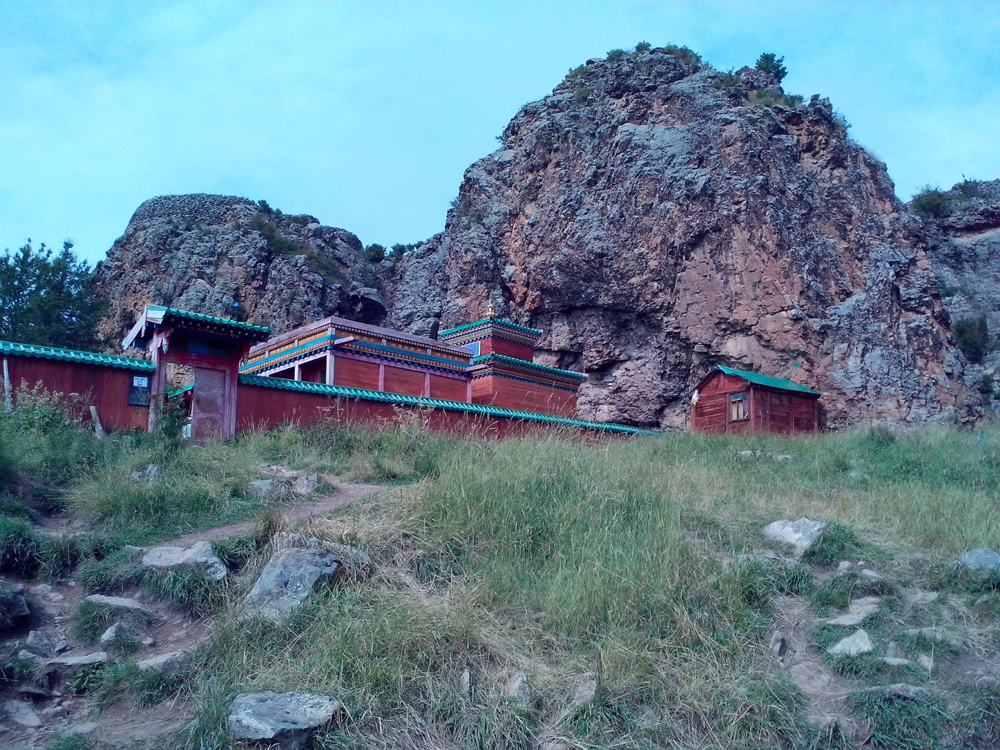 One of most beautiful monastery complex is situated on a forested rocky mountain called Shireet Ulaan, which elevated in 2300 meters above sea level.
One of most beautiful monastery complex is situated on a forested rocky mountain called Shireet Ulaan, which elevated in 2300 meters above sea level.
The monastery was built in 1654 by Saint Zanabazar who was a great sculptor and one of the biggest representatives of Buddhism in Mongolia. Upon his return in 1651 from his first trip to Tibet he had a small walled stone meditation hut built here. 1653, he visited Erdenezuu, founded by his great grandfather, and appeared before a convocation of khalkha nobility. While there he prevailed upon his followers to build temple and retreat at Shireet Ulaan Uul in his own personal use. Later it became worship where many of his famous artworks were created; including five transcendent Buddha's now located in the Zanabazar Fine Art Museum and Choijim Lama Musuem. Zanabazar also reportedly designed his Soyombo Alphabet while his residing here. During Zanabazar's lifetime retreat was called Bayasgalant Aglag Oron (Happy Secluded Place). After his death it became Tuvkhun Monastery, the name which it is known today. The small temple was heavily damaged by communists during the upheavals of the late 1930s. During the summer of 1997 extensive ceremonies were performed here and new statue of deity Gombo Makhagal (Mahakala) was placed in top of refurbished and consecrated. Several monks live at the monastery full time.
Khorgo-Terkh National Park
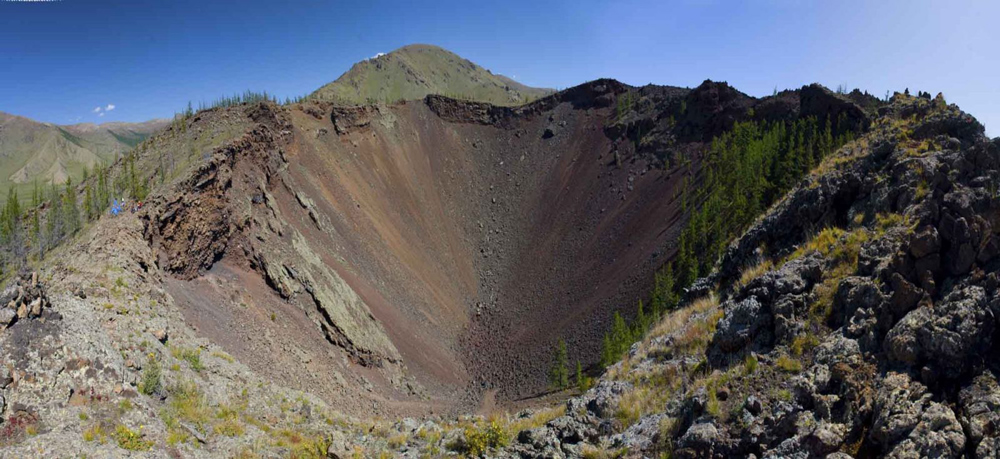 The National Park covers 28 sq.km including Togoo Uul which reaches 2240 m above sea level and Hill of Terkhiin Tsagaan Lake. It has been protected since 1965, fully in 1997, to safeguard spectacular mountain scenery and endangered flora and fauna. It's surrounded by the Khangai Mountains, which reach as 3000 meters above the sea level. Khorgo Mountain is dead volcano, which lies east of Terkhiin Tsagaan Lake. The mountain is covered with basalt. The volcano crater of the Togoo Uul is 200 meters wide and 100 meters deep.
The National Park covers 28 sq.km including Togoo Uul which reaches 2240 m above sea level and Hill of Terkhiin Tsagaan Lake. It has been protected since 1965, fully in 1997, to safeguard spectacular mountain scenery and endangered flora and fauna. It's surrounded by the Khangai Mountains, which reach as 3000 meters above the sea level. Khorgo Mountain is dead volcano, which lies east of Terkhiin Tsagaan Lake. The mountain is covered with basalt. The volcano crater of the Togoo Uul is 200 meters wide and 100 meters deep.
Terkhiin Tsagaan Lake
 Terkhiin Tsagaan Lake is an astonishingly beautiful lake with relatively pure fresh water. Torrents of lava issuing from the Khorgo volcano blocked the north and south Terkh Rivers, so forming the dammed lake of Terkhiin Tsagaan Lake at an altitude of 2060 meters above sea level. The lake is 16 km wide, 4-10 meters deep with its deepest point at 28 meters and over 20 kilometers in length.
Terkhiin Tsagaan Lake is an astonishingly beautiful lake with relatively pure fresh water. Torrents of lava issuing from the Khorgo volcano blocked the north and south Terkh Rivers, so forming the dammed lake of Terkhiin Tsagaan Lake at an altitude of 2060 meters above sea level. The lake is 16 km wide, 4-10 meters deep with its deepest point at 28 meters and over 20 kilometers in length.
Tsenkher hot spa
Tsenkher is hot spring, which emerges from the ground at 85 Celsius degree. It is located in Arkhangai province. The waters of the spring contain hydrogen sulfide and considered as having curative properties for joints and other ailments. It is an excellent place to relax.
NORTHERN MONGOLIA
The highlight of Mongolia’s Northern provinces, an alpine region bordering the forests of Siberia, is the pristine Lake Khuvsgul, known as Mongolia’s “blue pearl.” Believed to be several million years old, Mongolia’s deepest freshwater lake is surrounded by dozens of small rivers and streams that empty into its waters, pristine taiga forest, and valleys and meadows rich with wildflowers. Northern Mongolia offers a chance to see a large population of reindeer. Among the nomadic peoples who inhabit Mongolia’s northern forests and steppe are the Tsaatan, members of a small Tuvanian ethnic group who have herded domesticated reindeer for centuries. The culture of these herdsmen has changed little since the Ice Age, and like many of Mongolia’s nomads, and particularly those in the north, shamanism plays an important role in their lives.
Places to visit: Pristine Lake Khuvsgul, Ancient Uushig deer stones, Amarbayasgalant monastery, Extinct volcano Uran mountain.
Activities: Horse riding, hiking, trekking, exploring pristine nature, fishing, kayaking, rafting, visiting to tsaatan(reindeer breeding) family, experiencing shamanism.
Khuvsgul Lake
.jpg) Try to imagine a 2760 sq km (1080 sq mi) alpine lake, with water so pure you can drink it. Then add dozens of 2000m (6560ft) mountains, thick pine forests and lush meadows with grazing yaks and horses, and you have a vague impression of Khuvsgul Lake, Mongolia's top scenic heart stopper. This is the deepest lake in Central Asia, with a maximum depth of 262metres and the world's 14th largest source of fresh water. Situated along the border with Russia, the lake is sacred to local Mongolians, who refer to it as 'mother'. It's full of fish and the area is home to sheep, ibex, bear and moose, as well as over 200 species of birds. Three separate peoples live in the area: Darkhad Mongols, Buryats and Tsaatan. It is impossible to imagine Mongolia without the uniquely magnificent and pristine land of Khuvsgul or Lake Khuvsgul. Lake Khuvsgul covers an area of 2760sq.km and exists at 1605 m above sea level. Its water is crystal clear and fresh.
Try to imagine a 2760 sq km (1080 sq mi) alpine lake, with water so pure you can drink it. Then add dozens of 2000m (6560ft) mountains, thick pine forests and lush meadows with grazing yaks and horses, and you have a vague impression of Khuvsgul Lake, Mongolia's top scenic heart stopper. This is the deepest lake in Central Asia, with a maximum depth of 262metres and the world's 14th largest source of fresh water. Situated along the border with Russia, the lake is sacred to local Mongolians, who refer to it as 'mother'. It's full of fish and the area is home to sheep, ibex, bear and moose, as well as over 200 species of birds. Three separate peoples live in the area: Darkhad Mongols, Buryats and Tsaatan. It is impossible to imagine Mongolia without the uniquely magnificent and pristine land of Khuvsgul or Lake Khuvsgul. Lake Khuvsgul covers an area of 2760sq.km and exists at 1605 m above sea level. Its water is crystal clear and fresh.
Uushig deer stones
A deer-decorated stones in Uushigiin uver of Khuvsgul province considered as most clearly depicted deer stones in Mongolia. These deer stones were aligned from north to south in a single column. Each stone is 3-20m distant from each other and made of tetrahedral granite stone in reddish color. A deer, an arch, a shield, a horse, a knife, the moon, the sun and a mirror figured belt were engraved on the stones.
There are around 900 hundred of these deer stones in the world, and 700 hundred of them found in Mongolia. Deer stones are ancient megaliths carved with symbols found largely in Siberia and Mongolia.The name comes from their carved depictions of flying deer. There are many theories to the reasons behind their existence and the people who made them.
Deer stones are usually constructed from granite or greenstone, depending on which is the most abundant in the surrounding area. They have varying heights; most are over 3 feet tall, but some reach a height of 15 feet. The tops of the stones can be flat, round or smashed, suggesting that perhaps the original top had been deliberately destroyed. The stones are usually oriented with the decorated face to the east.
The carvings and designs were most usually completed before the stone was erected, though some stones show signs of being carved in place.[ The designs were pecked or ground into the stone surface. Deep-grooved cuts and right-angle surfaces indicate the presence of metal tools. Stone tools were used to smooth the harsh cuts of some designs. Nearly all the stones were hand carved, but some unusual stones show signs that they could have been cut with a primitive type of mechanical drill.
Reindeer feature prominently in nearly all of the deer stones. Early stones have very simple images of reindeer, and as time progresses, the designs increase in detail. A gap of 500 years results in the appearance of the complicated flying reindeer depiction. Reindeer are depicted as flying through the air, rather than merely running on land. The antlers, sometimes appearing in pairs, have become extremely ornate, utilizing vast spiral designs that can encompass the entire deer. These antlers sometimes hold a sun disc or other sun-related image. Other artwork from the same period further emphasizes the connection between the reindeer and the sun, which is a very common association in Siberian shamanism. Tattoos on buried warriors contain deer tattoos, featuring antlers embellished with small birds' heads. This reindeer-sun-bird imagery perhaps symbolizes the shaman's spiritual transformation from the earth to the sky: the passage from earthly life to heavenly life. As these deer images also appear in warrior tattoos, it is possible that reindeer were believed to offer protection from dangerous forces. Another theory is that the deer spirit served as a guide to assist the warrior soul to heaven.
Tsaatan people&Shamanism
The Tsaatan people of northern Mongolia are a nomadic people who depend on reindeer for nearly all aspects of survival, as well as cultural, spiritual, linguistic, and economic identity. There are small ethnic Tuvanian people originated from Russian Siberia. Today just over 200 Tsaatan individuals live in the Mongolian taiga, an ecosystem characterized by larch trees, high moisture, and sub-arctic conditions. They move regularly within two main camp areas, between West and East Taiga, seeking pasture for their deer. Tsaatan maintain small herds of between 7 and 160 reindeer per family. Reindeer are milked daily, providing the staple component of the Tsaatan diet largely consisting of reindeer dairy products. They are an essential mode of transportation in the high mountain, road-less taiga. The people living in the northern part of Mongolia (Darkhad, Tsaatan, Khotgoit,) still maintain the ancient shamanic traditions. Mongolian shamanism is a practice that involves a practitioner reaching altered states of consciousness in order to encounter and interact with the spirit world, and channel these transcendental energies into this world. A shaman is a person regarded as a having access to, and influence in the world of benevolent and malevolent spirits, who typically enters into a trance state during a ritual, and practices divination and healing.
Amarbayasgalant Monastery
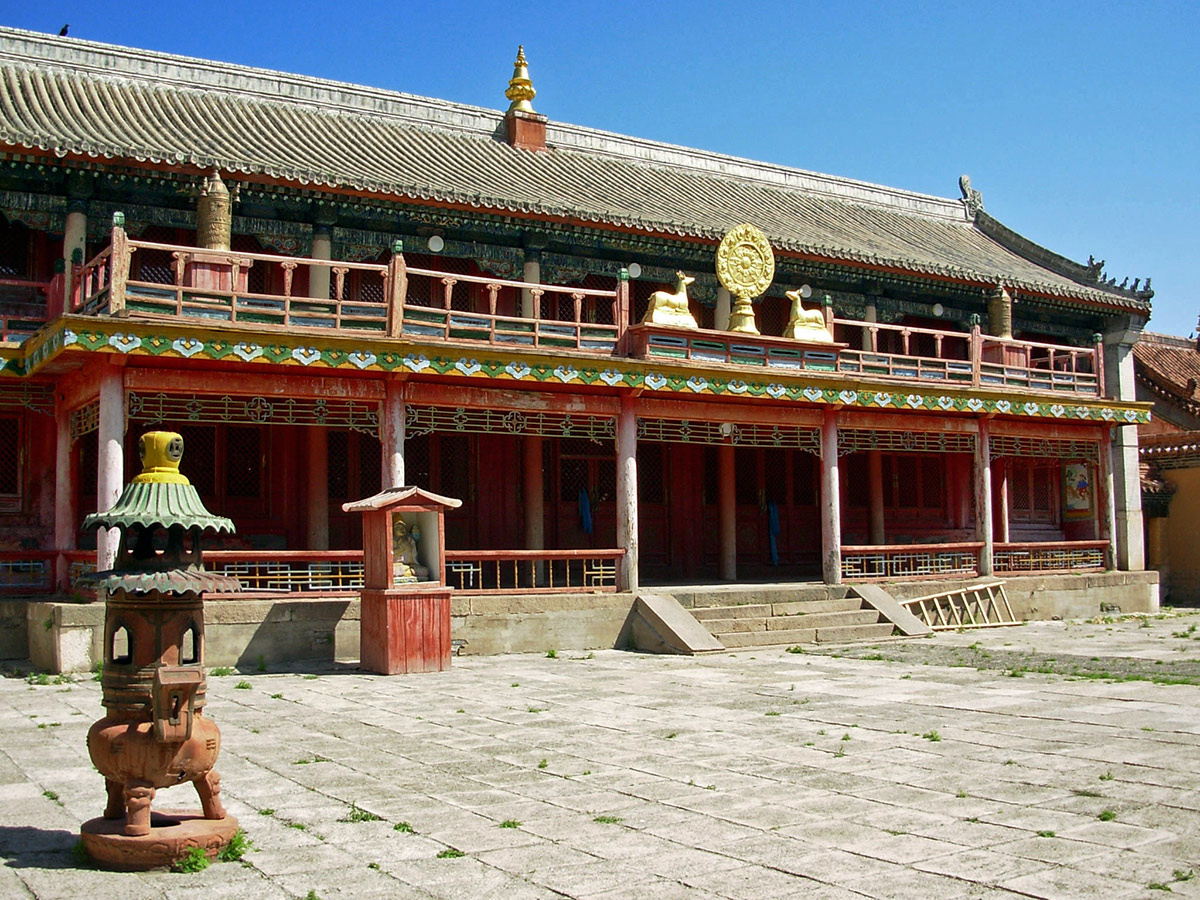 Amarbayasgalant, one of the most well known and largest monasteries of Mongolia, is located in the beautiful Iven Gol River valley on the foot of Burenkhan mountain and is about 360 km of north of Ulaanbaatar. Visitors especially enjoy the magnificent art and architectural construction. The beauty, decorations and construction of the monastery have made it one of the most magnificent architectural monuments not only in Mongolia, but in the whole Asia. The monastery was established by order of Manju emperor Enkh- Amgalan Khan, to cherish and give respect to the Undur Geghen Zanabazar, the first Buddhist saint of Mongolia, for his skills, wisdom, intellect and accomplishments. 3730 kg of silver from the state fund were used to build a magnificently styled place for Buddha teaching and practice in honor of Zanabazar. After searching for a suitable place, the construction works of the monastery called “ Amarbayasgalant -a palace for God `s meditation , began in the year of red horse,1726, and was completed in the year of red dragon, 1736. During the 1937-s repression covered Amarbayasgalant Monastery and all the highly trained knowledgeable monks were executed. Also huge numbers of rare religious relics, books, sutras, thangkas and Buddhas which had been collected for 200 years, were destroyed completely. 1990 was the time when the circumstances came for Amarbayasgalant to be restored. Under Geghen's monastery Amarbayasgalant was reestablished and nowadays stands strong on it's remarkable construction, as on it's 300 year history.
Amarbayasgalant, one of the most well known and largest monasteries of Mongolia, is located in the beautiful Iven Gol River valley on the foot of Burenkhan mountain and is about 360 km of north of Ulaanbaatar. Visitors especially enjoy the magnificent art and architectural construction. The beauty, decorations and construction of the monastery have made it one of the most magnificent architectural monuments not only in Mongolia, but in the whole Asia. The monastery was established by order of Manju emperor Enkh- Amgalan Khan, to cherish and give respect to the Undur Geghen Zanabazar, the first Buddhist saint of Mongolia, for his skills, wisdom, intellect and accomplishments. 3730 kg of silver from the state fund were used to build a magnificently styled place for Buddha teaching and practice in honor of Zanabazar. After searching for a suitable place, the construction works of the monastery called “ Amarbayasgalant -a palace for God `s meditation , began in the year of red horse,1726, and was completed in the year of red dragon, 1736. During the 1937-s repression covered Amarbayasgalant Monastery and all the highly trained knowledgeable monks were executed. Also huge numbers of rare religious relics, books, sutras, thangkas and Buddhas which had been collected for 200 years, were destroyed completely. 1990 was the time when the circumstances came for Amarbayasgalant to be restored. Under Geghen's monastery Amarbayasgalant was reestablished and nowadays stands strong on it's remarkable construction, as on it's 300 year history.
Extinct volcano Uran Mountain
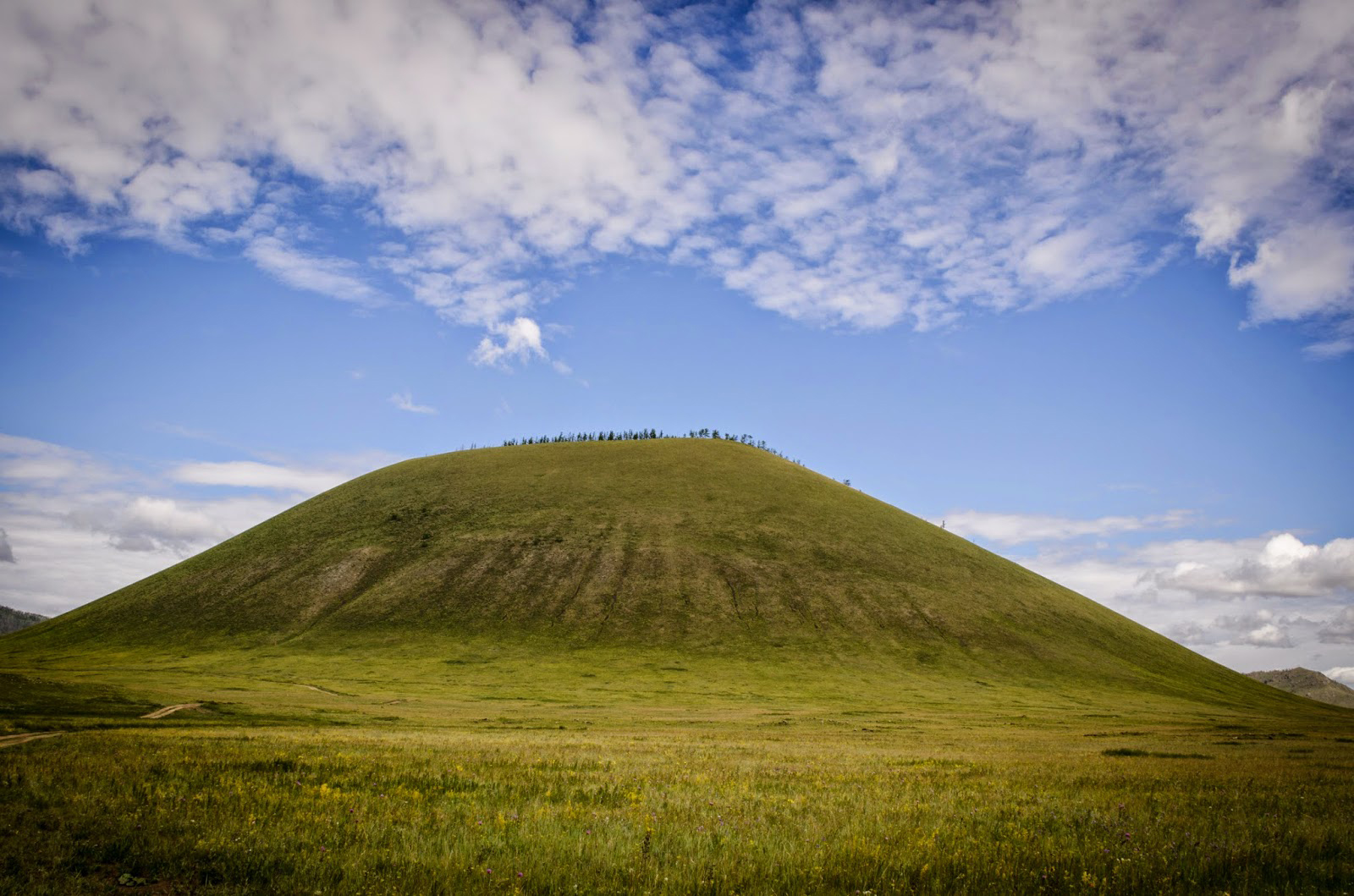 Uran Mountain lies west of Bulgan city en route to Khuvsgul area. This is an extinct volcano with crater of 600 meter wide and 50 meter deep filled with small Crater Lake. Extinct volcano of Uran Mountain and nearby Togoo Mountain, now part of the 1600 hectare Uran-Togoo Tulga Uul Natural Reserve in the sum (district) of Khutag-Ondor. This mountain ranks as 4th highest mountain in Bulgan province. It is located about 60 km directly west of Bulgan city. Uran Mountain is a pretty good place to break the journey to Khuvsgul. It has been protected since 1965, and today enjoys the statue of Natural Monument. It is really fascinating mountain and home for Red deer, Argali-sheep, Wild boar, Siberian ibex and Ruddy shelduck.
Uran Mountain lies west of Bulgan city en route to Khuvsgul area. This is an extinct volcano with crater of 600 meter wide and 50 meter deep filled with small Crater Lake. Extinct volcano of Uran Mountain and nearby Togoo Mountain, now part of the 1600 hectare Uran-Togoo Tulga Uul Natural Reserve in the sum (district) of Khutag-Ondor. This mountain ranks as 4th highest mountain in Bulgan province. It is located about 60 km directly west of Bulgan city. Uran Mountain is a pretty good place to break the journey to Khuvsgul. It has been protected since 1965, and today enjoys the statue of Natural Monument. It is really fascinating mountain and home for Red deer, Argali-sheep, Wild boar, Siberian ibex and Ruddy shelduck.
SOUTHERN MONGOLIA
The Southern Mongolia is known for its Gobi desert, one of the world’s most unique ecosystems. When people imagine of Mongolian Gobi, they imagine wide-open unfertile land or continuous massive sand dunes. When you travel Mongolian Gobi, your imagination will be broken completely. Mongolian Gobi is a combination of massive sand dunes, wide-open stony, but has vegetation steppes, marvelous rugged mountains rich in flora and fauna, oasis, rivers and streams. The region is famous for its unique nature formations, as well as rich dinosaur fossils and two humped Bactrian camels.
Places to visit: Gobi Gurvan Saikhan National Park, Eagle valley, Khongor sand dunes, Flaming cliffs, White stupa, Baga gazriin chuluu, Ongi temple.
Activities: Camel and horse riding, hiking, trekking, sightseeing, nomadic culture experiencing, wildlife viewing, visiting archeological site.
Gobi Gurvan Saikhan National Park
Situated to the west of Dalanzadgad town, Gobi Gurvansaikhan (“Three Beautifies of the Gobi”) park encompasses the series of ridges and valleys that make up the eastern end of the Gobi Altai Mountains. Surrounded by low plains, the mountains rise to 2200-2600 meters above sea level, and include the “Three Beauties” (three adjacent ridges named East, Middle, and the West Beauty), Zuulun, Sevrei, Gilbent, and Nemegt ridges. The park, which extends for more than 380 kilometers from west to east, has extremely varied landscape with rocky and sandy desert plains, precipitous cliffs and ravines, salt pans and oases. Gurvan Saikhan includes the highest diversity of plant and animal life in the Gobi Altai with over 620 species of flowering plants and all 52 species of mammals that are found in the Gobi desert region.
The Gobi Gurvan Saikhan National park features some of the most popular tourist destinations, including the picturesque gorge of Eagle valley, and the Khongor Sand Dunes-largest sand dunes of Mongolia, a spectacular sea of sand dunes bordered by red sandstone formations, an oasis and a saxaul forest. The Nemegt, Hermen tsav, and Bayanzag flaming cliffs, the sites of numerous important dinosaur fossil discoveries, also lie within the park.
Eagle Valley-Yolyn Am
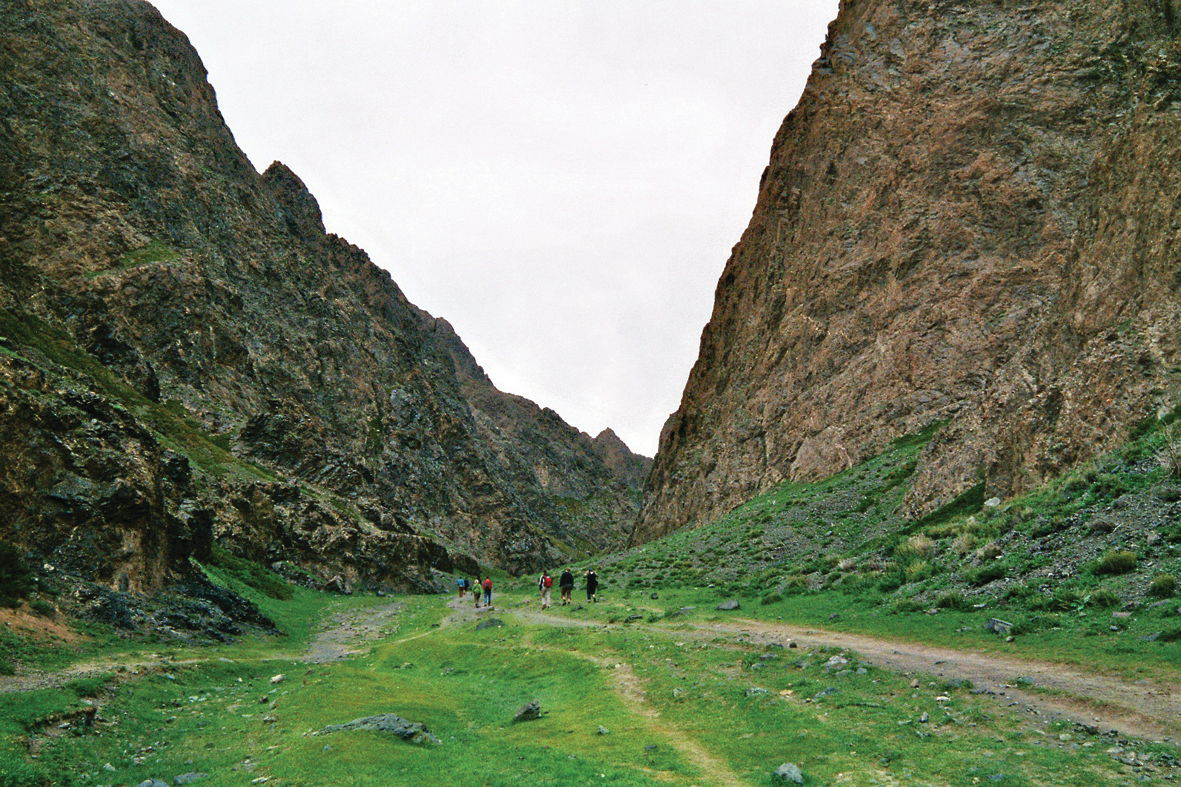 It’s one of the natural secret of Gobi Gurvan Saikhan National Park and beautiful deep canyon with many rocky cliffs, has been created by many years of water erosion. The Eagle Valley ( Yolyn Am), a protected site in 1965, is 62 km north west of Dalanzadgad. Very wide at the entrance, it narrows gradually into a remarkable gorge. A spring 2 or 3 km long winds its way through the defile and in July, freezing into a thick corridor of ice that stretches along a considerable distance. In earlier times, the blocks of ice rarely melted, being protected from the vicious sunlight. This however has changed in recent years, partially because of the multitudes of tourists that walk on the ice. You can still see ice here in July but it is almost completely melted by August. Following the canyon to the very end, one emerges into a beautiful wide valley. Surrounding mountains are home to argali, ibex, and many birds of prey, as well as numerous small rodents particular to the Gobi. A small museum marks the entrance to the protected zone and provides information on the petrified trees, fauna and flora of the Gobi. The walk along canyon must be done on foot.
It’s one of the natural secret of Gobi Gurvan Saikhan National Park and beautiful deep canyon with many rocky cliffs, has been created by many years of water erosion. The Eagle Valley ( Yolyn Am), a protected site in 1965, is 62 km north west of Dalanzadgad. Very wide at the entrance, it narrows gradually into a remarkable gorge. A spring 2 or 3 km long winds its way through the defile and in July, freezing into a thick corridor of ice that stretches along a considerable distance. In earlier times, the blocks of ice rarely melted, being protected from the vicious sunlight. This however has changed in recent years, partially because of the multitudes of tourists that walk on the ice. You can still see ice here in July but it is almost completely melted by August. Following the canyon to the very end, one emerges into a beautiful wide valley. Surrounding mountains are home to argali, ibex, and many birds of prey, as well as numerous small rodents particular to the Gobi. A small museum marks the entrance to the protected zone and provides information on the petrified trees, fauna and flora of the Gobi. The walk along canyon must be done on foot.
Khongor Sand Dune-Khongoryn Els
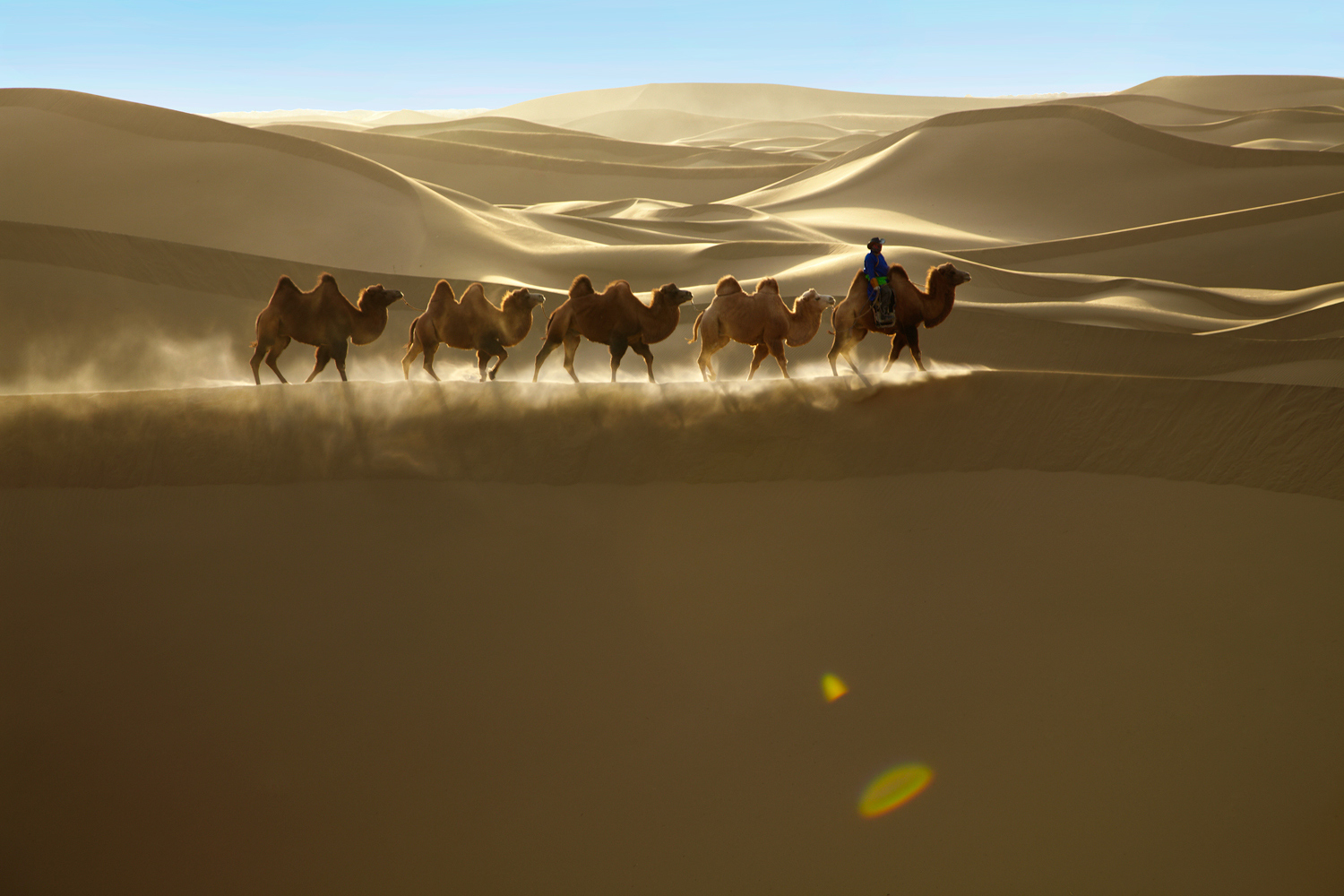 A Mongolian largest sand dune named Khongoryn Els has an extraordinary length of 180 kilometers and 15-20 kilometers wide, reaching a height of impressive 300-400 meters. One of the best places to observe booming dunes in the southern Mongolia is Khongor Sand dunes. The sounds have been variously described as singing, whistling, squeaking, roaring and booming. To stand before an enormous, gleaming white sand dune and realize that all of this was once an ancient lake bed or coastal plain is quite astonishing. The incredible roaring sounds of distant dunes is an unforgettable experience, particularly during the quiet hours of darkness and daybreak. Starting with the wind and tumbling particles of sand and culminating in picturesque drifts of rippled sand with an entire, dynamic, living community of plants and animals; this is one of nature's most remarkable cycles, and it is truly a phenomenon of wind. At the northern edge of the dunes on the bank of Khongor River, there is oasis, which is rich in plantation and supports drinking water of animal species in the region.
A Mongolian largest sand dune named Khongoryn Els has an extraordinary length of 180 kilometers and 15-20 kilometers wide, reaching a height of impressive 300-400 meters. One of the best places to observe booming dunes in the southern Mongolia is Khongor Sand dunes. The sounds have been variously described as singing, whistling, squeaking, roaring and booming. To stand before an enormous, gleaming white sand dune and realize that all of this was once an ancient lake bed or coastal plain is quite astonishing. The incredible roaring sounds of distant dunes is an unforgettable experience, particularly during the quiet hours of darkness and daybreak. Starting with the wind and tumbling particles of sand and culminating in picturesque drifts of rippled sand with an entire, dynamic, living community of plants and animals; this is one of nature's most remarkable cycles, and it is truly a phenomenon of wind. At the northern edge of the dunes on the bank of Khongor River, there is oasis, which is rich in plantation and supports drinking water of animal species in the region.
Flaming Cliffs-Bayanzag
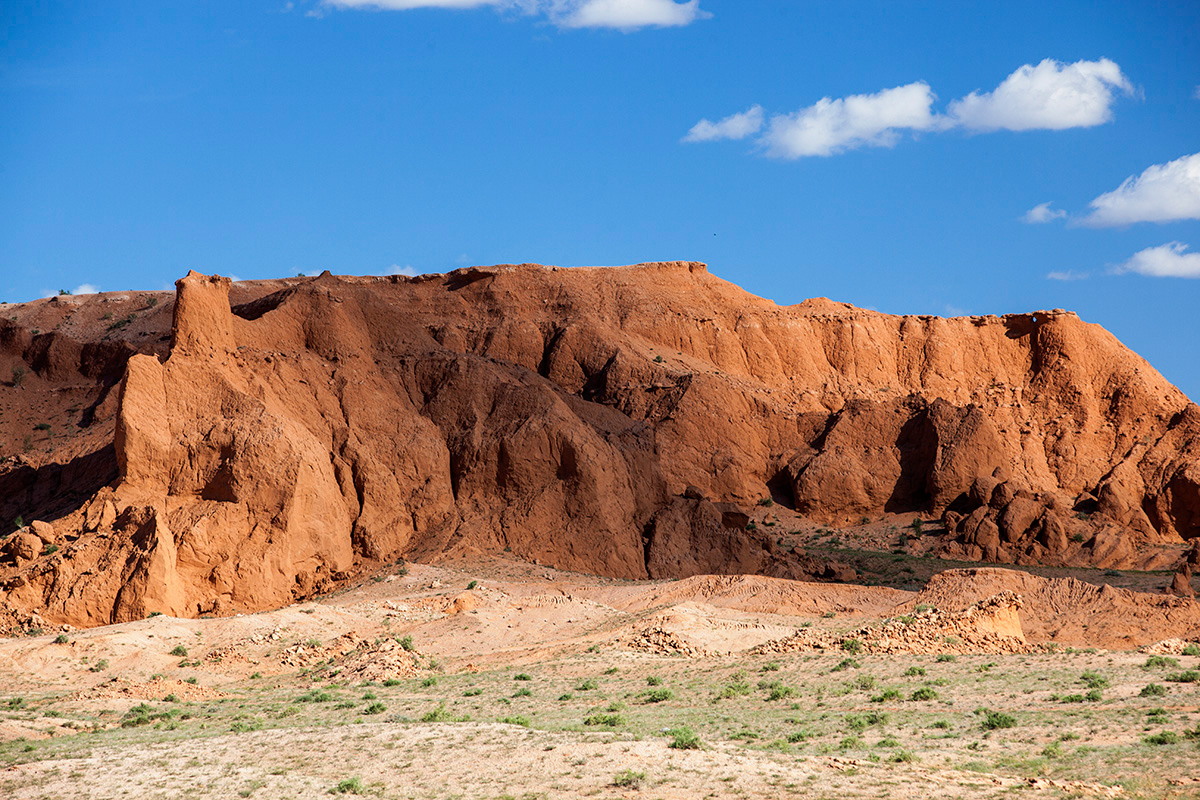 Bayanzag is located near by Bulgan Village, 597 km away to the south west of Ulaanbaatar city in Umnugobi province. This area is the birthplace of dinosaurs, and is renowned worldwide for the number of cretaceous dinosaur eggs and bones found here, which are discovered by famous American paleontologist Roy Chapman Andrews in 1922. In the same area he discovered petrified forests, remains of mammals and in particular the skeleton of a hornless rhinoceros, the largest known mammal in the world. Other finds in this location were complete dinosaur skeletons, eggs with a diameter of 10-15cm and hatch longs from the Cretaceous Period. Mongolia is considered second country of dinosaur finds while USA is first and 330 types of dinosaurs have been found in the world and 60 types of them are belong to Mongolia. This place is popular with the name “Flaming Cliffs” in the world, because American archeologists called so when they were in the Gobi in 1922. Not so far from the Flaming Cliffs, there is a forest of saxaul trees –Gobi trees with extremely deep roots.Bayanzag literally means "Rich in saxual trees". This tree only grows in central Asian Gobi. The tree is always green even in very dry summers. It supports nomads' animals with emergency feed in some very dry summers.
Bayanzag is located near by Bulgan Village, 597 km away to the south west of Ulaanbaatar city in Umnugobi province. This area is the birthplace of dinosaurs, and is renowned worldwide for the number of cretaceous dinosaur eggs and bones found here, which are discovered by famous American paleontologist Roy Chapman Andrews in 1922. In the same area he discovered petrified forests, remains of mammals and in particular the skeleton of a hornless rhinoceros, the largest known mammal in the world. Other finds in this location were complete dinosaur skeletons, eggs with a diameter of 10-15cm and hatch longs from the Cretaceous Period. Mongolia is considered second country of dinosaur finds while USA is first and 330 types of dinosaurs have been found in the world and 60 types of them are belong to Mongolia. This place is popular with the name “Flaming Cliffs” in the world, because American archeologists called so when they were in the Gobi in 1922. Not so far from the Flaming Cliffs, there is a forest of saxaul trees –Gobi trees with extremely deep roots.Bayanzag literally means "Rich in saxual trees". This tree only grows in central Asian Gobi. The tree is always green even in very dry summers. It supports nomads' animals with emergency feed in some very dry summers.
White Stupa-Tsagaan Suvarga
Tsagaan Suvarga (White Stupa) is located in Middle Gobi province. It is sheer slope and was an old seabed with sedimentary structure created by millions years and the different colors of the ground represent different times. The formation is over 50 m in its highest point and continues 400 m.
There is no clear date of geography research work and it is good spot take rest and overnight place driving to South Gobi desert from Middle Gobi desert. Its wall slope is looks like a ancient ghost city form a distance. There is 2 famous sites for explore. First one is a interesting cave which is 70 m long Khevtee Bosoo agui (Lie and Stand Cave) and not so far from the site. Second option is exploring Del uul (Back Mountain) for seeing rock drawings of Bronze Age. This is considered almost largest site of rock drawings in Central Asia.
Baga Gazriin Chuluu
These mountains with granite stone massifs are located in Middle Gobi Province. Baga Gazriin Chuluu, is a 15km long and 10 km wide stone massif, highest point is Tahilgat Mountain /1768 m/ in the Northwest part of the stone massif. Over 20 kinds of medical herbs and many species of animals such as wild sheep, ibex and marmot exist here, Surtiin am is one of many beautiful places in Baga gazriin stone massif. This is a narrow canyon with asp, birch, white wicker and elm tree, as well the ruin of a stone temple and the site of 2 Gers where monks lived and meditated since the 17 th century. Also, there is a spring water which comes from under source is good for eye illness.
Ongi Temple
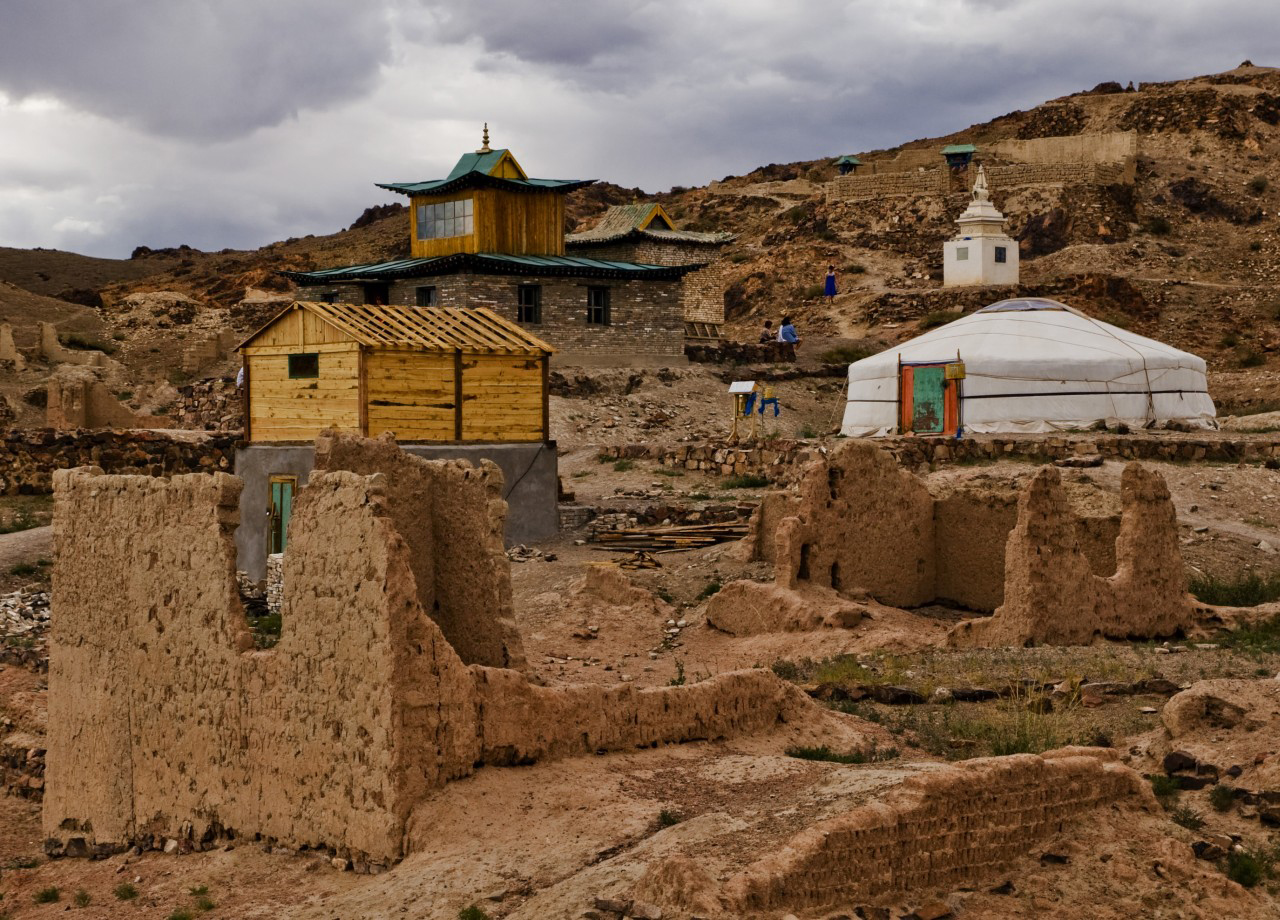 The ruins of Ongi temple are found in Saikhan-Ovoo village of Middle Gobi province and it is about 250 kms from Karakorum, en route to South Gobi. It is the ruin of a big monastery on the bank of the Ongiin River, which is one of the longest river in Mongolia has 435 km length and flows into Ulaan Nuur. A river takes source from the Khangai Mountain range in Ovorkhangai province..
The ruins of Ongi temple are found in Saikhan-Ovoo village of Middle Gobi province and it is about 250 kms from Karakorum, en route to South Gobi. It is the ruin of a big monastery on the bank of the Ongiin River, which is one of the longest river in Mongolia has 435 km length and flows into Ulaan Nuur. A river takes source from the Khangai Mountain range in Ovorkhangai province..
Formerly one of the largest monasteries in Mongolia, Ongi monastery was founded in 1660 and consisted of two temple complexes on the north and south banks of the Ongi River. The older southern complex consisted of various administrative buildings as well as 11 temples. The northern complex built in the 18th century, consisted of 17 temples-among them one of the largest temples in all Mongolia.
The Ongi monastery grounds also 4 religious universities and could accommodate over one thousand monks at a time. But during 1930s the monastery was completely destroyed and over 200 monks were killed by the communists. After democracy of Mongolia in 1990, monks returned to Ongi monastery where they had begun their Buddhist education as young children some 60 years prior. These monks started laying new foundation upon the old ruins, with a vision to restore Ongi monastery and revitalize Buddhism in Mongolia.
EASTERN MONGOLIA
Eastern Mongolia contains one of the largest – and last – undisturbed steppe ecosystems in the world, and is the core habitat of the Mongolian gazelle. There are meandering rivers, large wetland areas punctuated by beautiful lakes, swathes of multicolored wild flowers and huge herds of white-tailed gazelle. Besides the grasslands, the major feature of the region is the Khan Khentii Mountains, where was the birthplace of Genghis Khan.
Places to visit: Khan Khentii Mountain National Park, Onon Balj National Park, Oglogch Kherem, Deluun Boldog, Bereeven Monastery, Khukh Lake, Rashaan Khad.
Attractions: Hiking, horse riding, nomadic culture experiencing, sightseeing, camping in the wild, kayaking, fishing, bird watching, monastery visiting.
Khan Khentii Mountain National Park
This is the native land of Chinggis khan and contains many important historical and cultural sites. Khan Knentii Mountain NP was registered by UNESCO as a World Cultural Heritage Site in 1996 and located northeast of the capital city. Khan Khentii is covered with forests, taiga and mountain forest steppe. It is the land described in the Secret History of Mongols, a literary monument of the nation.
Onon Balj National Park
The Onon-Balj basin is located at the southern edge of Siberian boreal coniferous forest and stretched into Daurian steppe. Situated at the juncture of two big ecosystems of central Asia, the area is unique with its natural formation and rich in biodiversity. Yet, the ecosystem is very fragile. The forest and steppe landscape, its composition and specific ecological functions, also serves as a home to a number of rare and endangered species in Mongolia and the globally endangered birds such as white-naped crane, hooded crane and great bustard and a number of aquatic Asian species. In addition to its nature beauty and picturesque areas, the basin is abundant with historically and culturally important areas, particularly the historical sites related to Chinggis Khan, the Great Mongolian Emperor and other historical, cultural, scientific and ecological significant areas. The Onon-Balj was taken under the State protection in 2000 as a National Park, with 415,752 hectare area, to protect the biodiversity and its genetic bank and to develop environmentally friendly tourism based on natural and historical sites.
Khukh Nuur
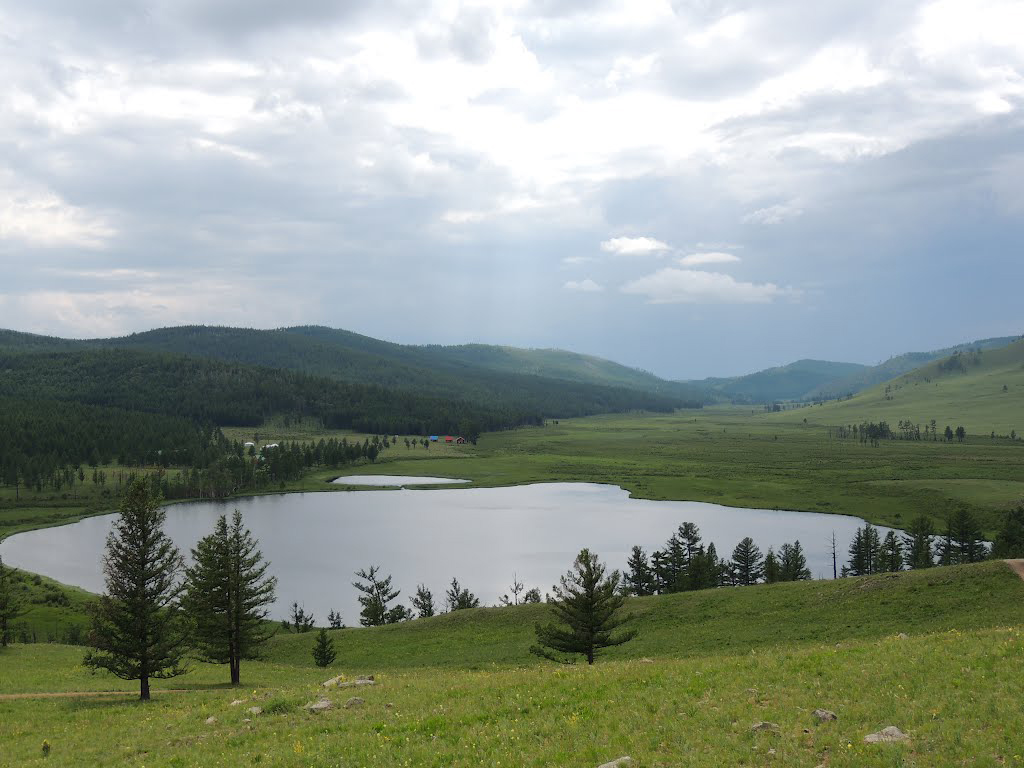 Khukh Nuur” in the Khar Zurkh Mountain is a beautiful place located in Khentii province. Besides being a beautiful nature, the place is unique due to the fact that the most important event of history of Mongolia took place here. At this very place, 800 years ago in 1189, Temujin came to the throne of Mongolia and was given the honorific title of “Chinggis Khan”, meaning supreme or great. Therefore this place is closely linked to the life of great Chinggis Khan. The great contribution of Chinggis Khan to unify all the Mongol aimags and establish an empire that streched from Black sea to the Pacific ocean and Siberia to Tibet started from this place. Probably because Chinggis Khan had chosen this place as the starting point, he succeeded to establish such a great empire. “Khukh Nuur” in the Khar Zurkh Mountain is a beautiful fresh water lake located at 1675 meters above sea level. The surrounding areas of the lake are forested Mountains which together form one of the most attractive places in Mongolia. The stone ruins of a ger with a diameter of 15 meters on the south side of this lake could be the ruins of the palace ger where Chinggis Khan was proclaimed khan. There are also wooden statues in the forest dedicated to Chingis Khan and the next 32 khans of Mongolia. The surrounding area of Khukh Nuur is quiet and peaceful place, wonderful for hiking&relaxation.
Khukh Nuur” in the Khar Zurkh Mountain is a beautiful place located in Khentii province. Besides being a beautiful nature, the place is unique due to the fact that the most important event of history of Mongolia took place here. At this very place, 800 years ago in 1189, Temujin came to the throne of Mongolia and was given the honorific title of “Chinggis Khan”, meaning supreme or great. Therefore this place is closely linked to the life of great Chinggis Khan. The great contribution of Chinggis Khan to unify all the Mongol aimags and establish an empire that streched from Black sea to the Pacific ocean and Siberia to Tibet started from this place. Probably because Chinggis Khan had chosen this place as the starting point, he succeeded to establish such a great empire. “Khukh Nuur” in the Khar Zurkh Mountain is a beautiful fresh water lake located at 1675 meters above sea level. The surrounding areas of the lake are forested Mountains which together form one of the most attractive places in Mongolia. The stone ruins of a ger with a diameter of 15 meters on the south side of this lake could be the ruins of the palace ger where Chinggis Khan was proclaimed khan. There are also wooden statues in the forest dedicated to Chingis Khan and the next 32 khans of Mongolia. The surrounding area of Khukh Nuur is quiet and peaceful place, wonderful for hiking&relaxation.
Oglogch Kherem-Ancestors Wall
Oglogch Kherem is one of the most important historical places in Mongolia which date back to the time of Chinggis Khaan. The wall is located at the base of Daichin Mountain, 8-10km from confluence of Ugluch and Bayangol rivers and 45km southwest from Batshireet village of Khentii province. Mongolia-American archaeological team identified at least 60 ancient graves within the walls, indicating that it may have been a royal cemetery. The wall is 2.5-3m high, 2.5m wide and approximately 3km long.
Bereeven Monastery
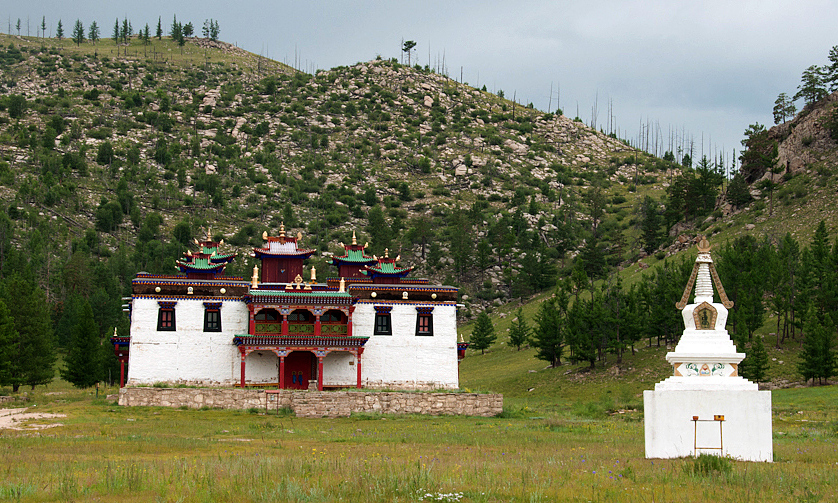 Bereeven monastery was established in the 17 th century by order of Zanabazar, the first Buddist Saint of Mongolia, and is located in Omnodelger village of Khentii province. The monastery of Baldan Bereeven is surrounded by four mountains each said to resemble an animal: a lion on the east; a dragon on the south; a tiger on the west; and a Garuda on the north. Each cardinal point is also guarded by a Protector Deity. The originally temple was demolished during the persecutions of the late 1930s and the Red Jamsram painting damaged or destroyed. The Jamsran rock painting in the temple now is thought by some to be the original but no one is quite sure. At its peak it was one of the three largest monasteries in Mongolia and home to 1500 lamas. It was destroyed by thugs in the 1930s and by fire in the 1970s. Now only ruins remain. On the rock above a complex of small temples, now in ruins, is a Soyombo, the head symbol of the Soyombo Alphabet invented by Zanabazar. This Soyombo was reportedly painted by Lama Dampilranjamba in the late eighteenth century. According to legend Dampilranjamba said, "This Soyombo will remain here long after the rest of the monastery is destroyed and fallen into ruins.” Indeed most of the monastery was destroyed in the late 1930s but the Soyombo painting was not defaced.
Bereeven monastery was established in the 17 th century by order of Zanabazar, the first Buddist Saint of Mongolia, and is located in Omnodelger village of Khentii province. The monastery of Baldan Bereeven is surrounded by four mountains each said to resemble an animal: a lion on the east; a dragon on the south; a tiger on the west; and a Garuda on the north. Each cardinal point is also guarded by a Protector Deity. The originally temple was demolished during the persecutions of the late 1930s and the Red Jamsram painting damaged or destroyed. The Jamsran rock painting in the temple now is thought by some to be the original but no one is quite sure. At its peak it was one of the three largest monasteries in Mongolia and home to 1500 lamas. It was destroyed by thugs in the 1930s and by fire in the 1970s. Now only ruins remain. On the rock above a complex of small temples, now in ruins, is a Soyombo, the head symbol of the Soyombo Alphabet invented by Zanabazar. This Soyombo was reportedly painted by Lama Dampilranjamba in the late eighteenth century. According to legend Dampilranjamba said, "This Soyombo will remain here long after the rest of the monastery is destroyed and fallen into ruins.” Indeed most of the monastery was destroyed in the late 1930s but the Soyombo painting was not defaced.
Rashaan Khad
Rashaan Khad is one of the important historical heritages in Eastern Mongolia. The Rashaan Khad is situated in the territory of Batshireet village of Khentii province. According to archeological study, the complex belongs to the period between Stone Age and the 16th century. There are full of ancient rock carvings and paintings depicting animals, humans, as well as other tribal symbols in different scripts including Arabian-Persian, Mongolian, Tibetan, Chinese and others.
Deluun Boldog-Birthplace of Chinggis Khan
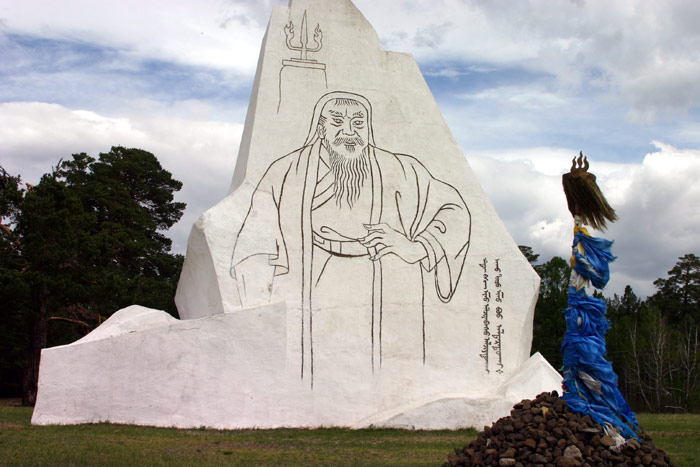 For his 800th birthday, a statue of Genghis Khan was erected in 1962 at Deluun Boldog; a place believed to be the great khan's birthplace, close to what is today Dadal soum, an attractive wooded area in North-West Khentii region.
For his 800th birthday, a statue of Genghis Khan was erected in 1962 at Deluun Boldog; a place believed to be the great khan's birthplace, close to what is today Dadal soum, an attractive wooded area in North-West Khentii region.
The area contains trails and lakes for visitors as well as monuments where you can learn why this fierce warrior and great leader is still revered today.Dadal Sum once housed one of three great lamaist temples consecrated to Chinggis Khan, but which was razed in the 1930s. Now there are stone monuments to him erected in the surrounding beauty of the Mongolian countryside. Also there is Burkhan Khaldun Mountain, which is mountain itself and/or its proximity areas are rumored to be the birthplace of Chinggis Khan, as well as the purported location of his tomb. The Burkhan Khaldun is one of the most sacred mountains in Mongolia.
The mountain is located in the 12,000 km² Khan Khentii Strictly Protected Area established in 1992. It is considered the most sacred mountain in Mongolia, because it was first designated as sacred by Chinggis Khan, although it previously had had strong religious significance prior to Chinggis Khan making it such a powerful landmark. This mountain is noted in Mongolian secret history which is historical note at Chinggis Khan’s rule time.
WESTERN MONGOLIA
Western Mongolia. This zone covers the three western provinces of Mongolia-Uvs, Bayan-Olgii, Hovd. The impressive Altai Mountain Range and great lakes depression make this region one of the most attractive place of the country. The diversity of ethnic groups residing in these regions is the great opportunity for cultural discoveries. Popular ones are Kazakh ethnic groups, who are residing in Bayan-Olgii province. The Kazakhs have a rich culture, close extended families, and many traditions that are still practiced today that are centuries old. The Kazakhs are the second largest ethnic group in Mongolia after the Khalkhs, with 101,000 people comprising 6% of the population. The western Mongolia is an ideal destination for adventurous tours such as trekking, climbing and hiking.





